|
Me Sahyadri |
|
April 2018 |
|
Volume 5, number 7, # 61 |
|
Mysteries of Maval Caves –Brahmi Inscriptions at Takwe Khurd Cistern |
Please use minimum 1280 pixel horizontal screen resolution for viewing. Please be patient while all the images in webpage are loaded. Please do not use the images for any commercial use without permission. Text in Marathi and English is not exact translation. Please give sufficient time to allow the photographs to load. Special thanks to those who helped me during the compilation and for the help and guidance during the activity. |
|
|
|
|
देशाची आर्थिक प्रगती व्हावी असे सर्व नागरिकांना वाटणे सहाजिक आहे. अर्थकारणामुळे मिळणारा रोजगार, समृद्धी यासाठी सर्वांनाच आर्थिक प्रगती हवी हवीशी वाटते. आर्थिक प्रगती होताना, त्याचा दिर्घकाळात समाजावर, निसर्गावर, वातावरणावर दुष्परिणाम होणार नाही याची काळजी घेणे महत्वाचे आहे. मनुष्याच्या भावी पिढ्यांना पाणी, शुद्ध हवा, योग्य वातावरण मिळत रहावे अशी भावना मनात रुजणे महत्वाचे आहे. वाढत्या आर्थिक प्रगतीमुळे नैसर्गिक संपदेवर ताण येतो. प्रगतीसाठी प्रदुषण होते. जंगले, माळराने, व इतर अधिवास नष्ट होतात. वसुंधरेवर रहाणाऱ्या इतर जीवांचा मात्र मनुष्य फारसा विचार करत नाही. आर्थिक प्रगती करताना, मनुष्य निसर्गाची हानी करत आहे. मुळताच माणसाला निसर्गाचे महत्व समजणे हे सध्याच्या आपल्या प्रगत जीवनशैली मुळे अवघड झाले आहे. आर्थिक प्रगती, समाजाची प्रगती व निसर्ग संपदेची निगा, यांचा समतोल राखणे काळाची गरज आहे.
सह्याद्री (पश्चिम घाट) हा एक नैसर्गिक संपदेचा, वैविध्यतेचा, भौगोलिक व ऐतिहासिक ठेवा आहे. वाढत्या मानवी अतिक्रमणाचा, सह्याद्रीच्या विविध घटकांवर होणारा दुष्परिणाम भविष्यात आपल्यालाच धोका निर्माण करेल, यात शंका नाही. शुद्ध पाणी, हवा व उर्जा, भावी पिढीला मिळण्यासाठी, नंद्यांचे उगम असलेला सह्याद्री व त्याभागातील जंगले टिकवणे महत्वाचे आहे. सह्याद्रीच्या महत्वाच्या घटकांचे महत्व छायाचित्रांद्वारे प्रकट करण्याचा मी येथे प्रयत्न केला आहे. येथील पक्षी, प्राणी, वनस्पती, अधिवास, किल्ले व लेणी अशा विविध विषयांबद्दल आपण समजुन घेऊ.
|
|
As the economic development has taken the center stage, the balance between the environmental sustenance and socio economic development will be under the scanner. As most experts with balanced views have proclaimed, Indian wildlife and ecological system sustenance will be under threat, unless precautions are taken with the help of appropriate research and long term national interests. As we encounter the economic development, many habitats which indirectly or directly help sustainable development will be damaged. The awareness to gauge the success by sustainable development and not by year to year growth is a distant dream any environmentalist will assume in current scenario.
Western ghats, or Sahyadri as we all call it as, is a treasure trove of spectacular landscapes, biodiversity, flora, fauna, some amazing geological wonders and man made monuments. With the increasing pressure from human encroachment, all these elements are under stress and in turn are under depletion. Western ghats should be left untouched by human beings, to protect their future generations from getting short of resources, such as water, energy and clean air. The important elements of western ghats, which need protection are highlighted in the new version of Photo journal, Me Sahyadri Magazine.
|
|
|
| |
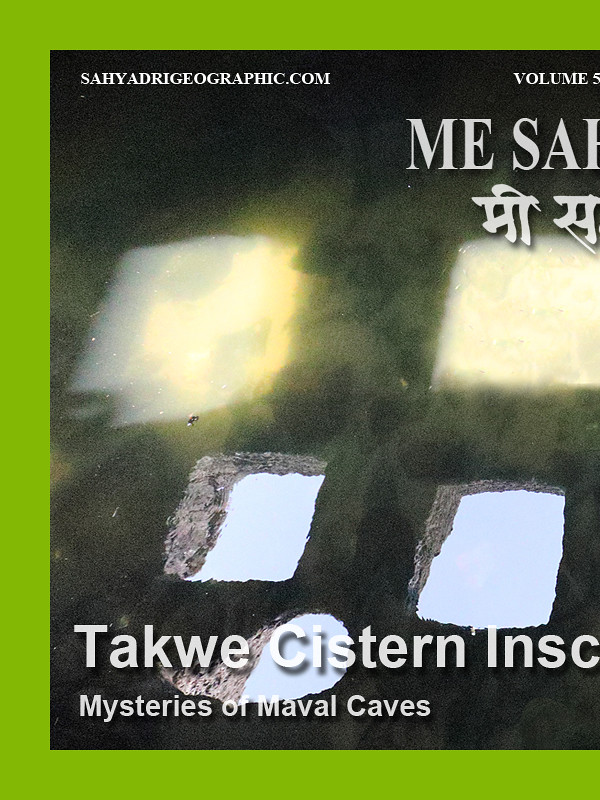 
|
| |
| Me Sahyadri – April 2018 - A
|
| |
|
|
मावळ लेणी मोहेमेचा सारांश :
मावळातील भाजे, बेडसे आणि कार्ले लेणी अप्रतिम आहेत. त्यामुळे या भागातील इतर लहान लेण्यांकडे फारसे कोणी फिरकत नाही. आम्ही चार समविचारी मित्रांनी मात्र या हरवलेल्या लेण्यांची शोधाशोध करण्याचे ठरवले. साईप्रकाश बेलसरे, निनाद बारटक्के, अमेय जोशी आणि विवेक काळे असा संघ तयार झाला. एकोणीसाव्या शतकात जेम्स बर्जेस आणि जेम्स फर्ग्युसन या दोन इंग्रज विद्वानांनी भारतातील लेणी धुंडाळली. त्यांनी १८८० साली "केव्ह टेम्पल्स ऑफ इंडिया" या पुस्तकाचे प्रकाशन केले. या पुस्तकात मावळातील लहान लेण्यांचा फारसा तपशिल नसला तरी, या मावळातील इतर लहान लेण्यांबद्दल ५-६ वाक्यांमध्ये आम्हाला त्रोटक का होईना माहिती मिळाली. त्यांनी उल्लेख केलेली, काही ठिकाण सापडली, तर काही ठिकाण काहीही केल्या सापडेनात. कदाचित न सापडलेली ठिकाण नष्ट झाली असावीत. पण मोहिमे दरम्यान नविन, ज्या ठिकाणांचा पुस्तकात उल्लेख नव्हता, पण ग्रामीण भागातल्या स्थानिकांना माहिती होती अशी ठिकाण सापडली.
जेम्स बर्जेस आणि जेम्स फर्ग्युसन या दोन इंग्रज विद्वानांनी लिहिलेल्या प्रत्येक शब्दाचा धागा म्हणुन वापर करायचे ठरले. कामांचे वाटप झाले.
शोध मोहिमेत लागणाऱ्या खाऊची सोय करणे, विषय आणि ठिकाणाचा आधी अभ्यास करणे, प्रवासाची सोय करणे, गावकऱ्यांकडे लेण्यांबद्दल चौकश्या करणे, मोहिमे दरम्यान गचपणातुन वाट शोधणे, लेण्याच्या अवशेषांची मोजमाप घेऊन त्याची चित्रे/नकाशे काढणे, छायाचित्रे काढणे, जि. पि. एस. यंत्रावर वाटेबद्दल माहिती नोंदवणे, लेण्यात लहान बारकावे शोधणे, लेण्यांचे विश्लेषण करणे, नोंदी करणे, अशी वेगवेगळ्या प्रकारची काम वाटुन घेण्यात आली.
प्रत्येक ठिकाणी जाताना, घरचा अभ्यास करावा लागला. जुनी पुस्तके, नकाशे धुंडाळले गेले. गावातल्या मित्रांची मदत झाली. गावागावात चौकश्या केल्या. गडद, लेणे, गुहा, कपार, भोगदा, विहार, पांडवांनी एका रात्री बनवलेली गुहा असे अनेक शब्द वापरुन चौकश्या झाल्या. बहुतेक वेळा असे काही नाही इथे ! तुम्ही कुठुन आलात ? असे उत्तर मिळाले. लेणे आहे का इथे कुठे असा प्रश्न विचारला तर आम्हाला बहुतेकांनी कार्ले/बेडसे/भाजे लेण्यांचा पत्ता दिला. पण बकऱ्या, गाई घेऊन डोंगरात फिरणारे गुराखी मात्र दरवेळेला मदतीला धाउन आले. वाटांचे आणि दिशांचे अंदाज मिळाले. जुजबी माहिती घेऊन ठिकाण शोधणे या प्रकाराचा चांगला सराव झाला. कधी काटेरी करवंदींच्या खालुन खुप सरपटाव लागल तर कधी घसाऱ्यावर हात टेकावे लागले.
लेण्यांमध्ये मोठे कोळी (स्पायडर), कातळ पाली, वटवाघळ, मधमाश्या, पाकोळ्या, घुबडं भेटले. आमच्या मुळे त्यांना उगाच त्रास झाला, असा अपराधीपणा वाटला. प्रत्येक शोधमोहिमेला यश आलेच असे नाही. काही ठिकाण सापडली नाहीत. तर काही ठिकाण आमच्याच मनाचे खेळ आहेत असे लक्षात आले. बहुतांश ठिकाणी कोणत्या ना कोणत्या प्रकारची जोखिम होती. वटवाघळ, लेण्यातील धुळ, काळोख, मधमाश्या, काटेरी वनस्पती, घसारा, गुहेतील ऑक्सिजन चा अभावआणि इतर न दिसणारे धोके यावर मात झाली. मोहिमेसाठी, विजेऱ्या, जि. पि. एस., मोजपट्या, दोऱ्या, लेजर यंत्र, नकाशे, गुगल मॅप, जाळीच्या टोप्या या सर्व जंत्रीचा उपयोग झाला. एकूण मिळुन २० नविन अपरिचित ठिकाण/वास्तु पहायला मिळाल्या, मावळाचा भुगोल जरा अजुन नीट लक्षात आला. नविन प्रश्न पडले आणि नविन कोडी सोडवयाला मिळाली. तर्क वितर्क झाले.
|
|
About the Maval Cave exploration :
The main caves in Maval region are so significant that other small hermit caves are often overlooked. We as a team of four like minded friends, decided to explore the Maval region for these small hermit caves. We explored and found few beautiful places. The very concept of creating a hermit cave somewhere high up in the hills is fascinating. These places often are full of tranquility and nothing else. With very little architectural evidences and clues, the academicians have obviously ignored these places. It was James Fergusson and James Burgess, during their exhaustive study of “Cave temples of India, 1880” mentioned few of these hermits in Maval region of Pune district. With the little clues and exhaustive investigation, team of four members, Saprakash Belsare, Amey Joshi, Ninad Bartakke and Vivek Kale started the exploration. The journey to locate, trek and analyse these hermit caves itself was fascinating. We met many villagers who were unaware of these places, but also met few shephards who were precisely aware of the hermits and gave us tentaive guidance.
There is a very brief mention about the misceleneous caves of Maval by James fergusson and James Burgess in their work. Based on available information we decided to search these caves and monuments. The activities were planned. The food, travel , track exploration in difficult and routes full of foliage, enquiring the villagers about the caves, taking measurements and drawing skecthes and maps, photography, GPS data collection, making notes and analysing the information, observing the minor details of the caves etc activites were distributed amongst the team members. We met many bats, owls, geckos, lizards, large spiders, martins, honeybees during the treks. Often we felt sad that we disturbed them to see the caves. Most of these places are hazardous due to pitch darkness, bats, dust, thorny plants, honeybees, low oxygen level in caves and rock patches etc. Not all the attemps were successful. Sometimes we could not find the intended places and sometimes we realised that the cave was just our imagination and did not exist. Nevertheless we saw about 20 new strange caves/monuments during the exploration. The high intensity torches, GPS tool, measuring tapes and measuring laser tool, Honeybee protection caps, maps, google maps, photographs etc were useful during the mission.
On this photoessay, I have compiled the information and photographs of one of the new find (for us) at Takwe Khurd Cistern with Brahmi Inscriptions. This is the most significant find we had during our Maval Cave mission.
|
|
|
| |
  |
| The banner has been published here to improve the awareness of the trekkers and tourists visiting the various mountain forts, mountains in north western ghats. Please avoid accidents, by following good outdoor ethics such as no swimming in cisterns at mountain forts, no rock climbing without proper technical equipment and expertise. Please do not adventure, trek with any group or individually without understanding the risks associated. The frequency of the solo trekker fatalities have increased recently. Please strictly avoid solo treks. Please also avoid treks to mountains in large commercial groups, as it leads to damage to biodiversity of these high elevation ecological islands. Please respect the wildlife and biodiversity of the region. This has become more important as the ever increasing human interference is leading to severe damage to fragile ecosystems. Please be aware of the wildlife and biodiversity of the mountains before visiting these mountains. Please follow outdoor ethics. Follow ASI and Forest department rules. The concept of use of symbols for outdoor ethics was conceived and designed by "Sahyadri Trekker Bloggers Group". |
| |
|
|
| |
 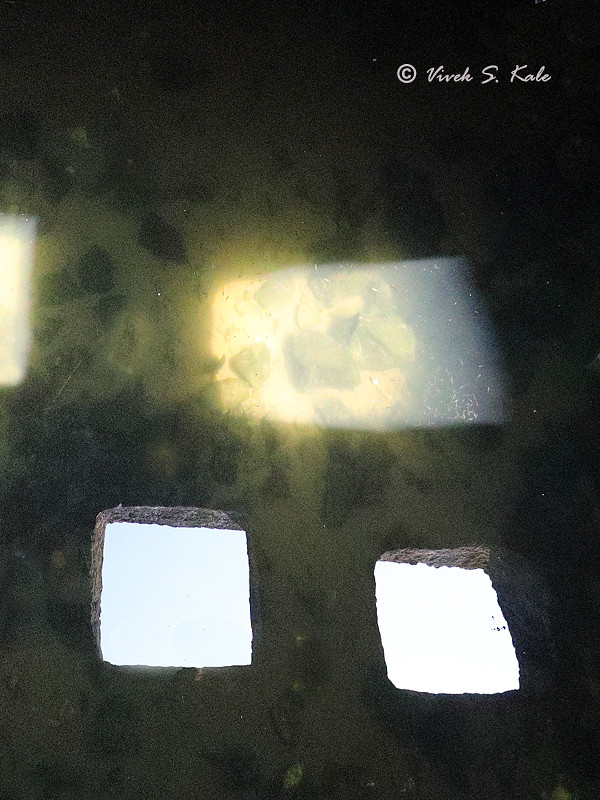 |
| |
| 1. Takwe Khurd Cistern with Brahmi Inscriptions, Maval Tehsil, Pune district, Maharashtra, India |
| |
|
|
टाकवे खुर्द पाण्याचे खांब टाक्याची शोधाशोध -
फर्ग्य़ुसन बर्जेस यांच्या पुस्तकात नऊ शब्द आहेत. " ॲट टाकवे स्टिल फर्दर इस्ट आर टू रॉक सस्ट्रंस." म्हणजे टाकवे येथे दोन पाण्याची टाकी आहेत. या नऊ शब्दांचा आधार घेत आम्ही पाच मित्र, अमेय जोशी, साईप्रकाश बेलसरे, निनाद बारटक्के , मिलिंद लिमये आणि विवेक काळे एक उन्हाळयातील रविवारी टाकवे भागात पोहोचलो. उन्ह मी म्हणत होत. अशी गचपणातील, डोंगरातील आणि गवत कारवीतील ठिकाण धुंडाळायची तर उन्हाळा सर्वात उत्तम ऋतू असतो. टाकवे भागाचा आम्ही गुगल मॅप वापरुन अभ्यास केलेला होताच, पण टाक्याचा नक्की ठावठिकाणा माहित नव्हता. गावाजवळ पोहोचल्यावर चौकशी केली असता, एका टाक्याची माहिती कळाली. दुसरे टाके मात्र सापडले नाही. गावाच्या हद्दीबाहेर, पुणे-मुंबई हमरस्त्याजवळ गावाच्या फाटयाजवळ टाके दिसले. टाके शाबुत आहे हे पाहुन आनंद झाला. आनंद गगनात न मावणे या वाक्यप्रचाराचा प्रत्यय खऱ्या अनुभूतीतुन आला. पाण्याच्या टाक्याचे निरिक्षण केले. याची मोजमापे घेतली. छायाचित्रे घेतली. टाक्यात अर्ध्या पातळीपर्यंत पाणी होते. लहान सहान बारकावे पाहिले गेले. सर्व नोंदी नोंद वहीत केल्या गेल्या. अचानक टाक्याच्या वर असलेल्या झरोक्यावर अस्पष्ट अक्षरे दिसली. त्यात बाह्मी "म" अक्षर पाहताच हा शिलालेख बाह्मी लिपीतला आहे हे पक्के झाले. जानेवारी महिन्यात कान्हेरी चा अद्वितिय लेणी समुहात सुरज पंडित सरांकडुन शिकल्यानंतर सुधारलेल्या माझ्या निरिक्षण क्षमतेचा उपयोग झाला. डोळ्यांना सहज दिसणाऱ्या आणि डोळ्यांना सहजपणे न दिसणाऱ्या दोन्ही प्रकारच्या वस्तु आणि बाबी, समजणे महत्वाचे असते. या दोन्हीतुन आपल्याला एखादया ऐतिहासिक वास्तुची समज येते. टाकवे खुर्द चे पाण्याचे टाके मावळातल्या प्राचीन व्यापारी मार्गावर असलेले सर्वात मोठे, आणि महत्वाचे टाके आहे यात कोणाचेच दुमत होणार नाही.
|
|
Takwe Khurd Cistern Search:
We had few words from Fergusson’s book as a clue, which are : “At Tankve still further east are two rock cisterns”
With few words from Fergusson’s book, five of us, Amey Joshi, Saiprakash Belsare, Ninad Bartakke, Milind Limaye and Vivek Kale reached Takwe Khurd early morning of a hot summer. We intentionally decided to visit the place in summer, as we wanted the cistern to be as dry as possible. Though we had guessed the Takwe Khurd location based on google map, we still were not sure about the exact location of two water cisterns mentioned by James Fergusson and James Burgess. After enquiry in temple near village we realised that the water cistern is close to old Mubai-Pune national highway close to the junction of Takwe Khurd village road and highway. We observed the water cistern. It is one of the most magnificent and significant ancient water cisterns I have seen in Maval. Unfortunately Fergusson and Burgess have not clearly described the details of the water cistern.
We took measurements, took photographs, observed the minute details and noted the important observations. After doing survey around the cistern and observing the region around the water cistern, we had surprise in store. The learnings I had from Dr. Suraj Pandit sir during the Kanheri workshop in January came handy. During the Kanheri workshop, Pandit sir tought the participants, the methods to see both visible and invisible Kanheri. The existing minute details in caves, and other rock cut structures such as water cistern in this case, can give enormous information about the complete finished structure which must have been, when it was made.
|
|
|
| |
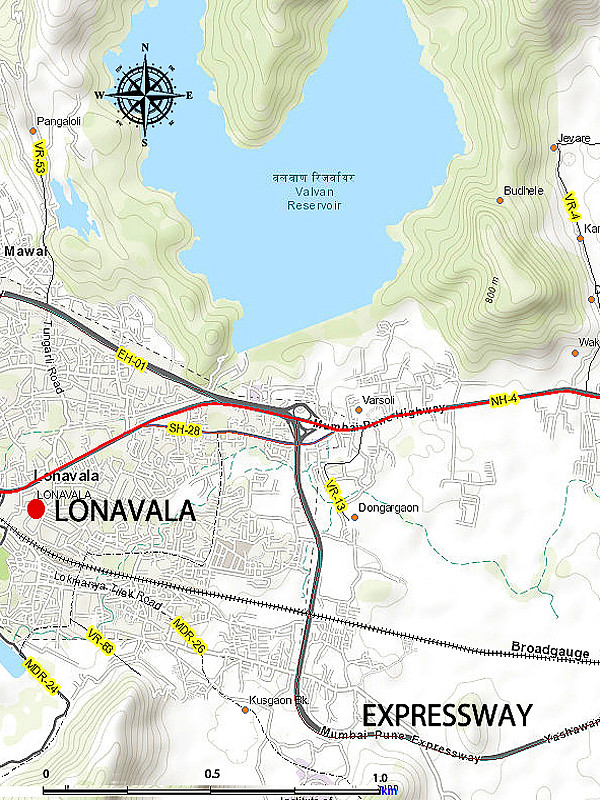 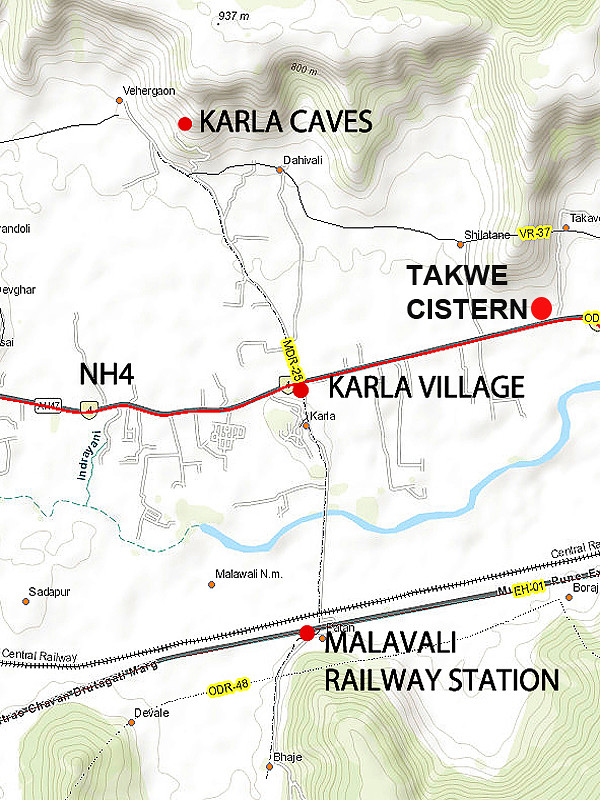 |
| |
| 2. Map- Takwe Khurd Cistern with Brahmi Inscriptions, Maval Tehsil, Pune district, Maharashtra, India |
| |
|
|
टाक्याच्या चार मुखातुन (झरोक्यातुन) टाक्याचे पाणी काढता येईल अशी सोय असावी. तिसऱ्या चौकोनी मुखावर (झरोक्यावर), एक फिकट कसा बसा वाचता येइल असा दोन ओळींचा शिलालेख आहे. कार्ले लेण्यातील शिलालेख वाचुन वाचुन केलेल्या सरावाचा उपयोग झाला. मिलिंद लिमयेने बाजुच्या अजुन एका झरोक्यावर शिलालेख असल्याचे ओळखले. हा दुसरा शिलालेख एका ओळीचा आहे. दोन्ही शिलालेख ब्राह्मी लिपीत आहेत. दोन्ही शिलालेखातील काही अक्षरे वाचता येतात. बहुसंख्य अक्षरे अस्पष्ट झालेली आहेत.
दुपारच्या उन्हात सुर्याच्या विशिष्ट जागी उपस्थितीमुळे आम्हाला शिलालेख दिसले. इतर वेळी आणि ऋतुत शिलालेख उमजणे अवघड आहे. बर्जेस आणि फर्ग्य़ुसन यांना या शिलालेखांचा ठावा लागला नाही. त्यांच्या लिखाणात याचा उल्लेख नाही. त्यानंतर कोणी या शिलालेखांचा अभ्यास केला
आहे का नाही हा एक अनुत्तरित प्रश्न आहे. कदाचित हे कोडे लवकरच उलगडेल. आम्ही शिलालेख तज्ञ नसल्याने आणि शिलालेख अत्यंत अस्पष्ट असल्याने शिलालेखाबद्दल जमेल तेवढ्या नोंदी येथे या लेखात केल्या आहेत.
पाण्याच्या टाक्याला पहिल्या भेटीनंतर बऱ्याच भेटी झाल्या. भर उन्हात चार तास अभय काळे सरांच्या मदतीने टाक्याची अचुक मोजमापे घेतली. बाळासाहेब येळवंडे आणि विवेक काळे यांनी भर उन्हात त्यांना मदत केली. टाक्याची आतुन मोजमापे घेणे अवघड आहे. पाणी असल्याने आणि गाळ असल्याने लेजर यंत्राचा वापर करत मोजमापे घेतली. जमिनीवरच्या वास्तुची मोजमापे घेताना होणाऱ्या कष्टांपेक्षा अधिक कष्ट अशा जमिनीखालच्या टाक्याची मोजमापे घेताना पडतात. या सगळ्या मोजमापे घेण्याच्या प्रतापातुन बऱ्याच गोष्टी शिकायला मिळाल्या. याचा उपयोग मावळातील इतर लेणी पहाताना झाला.
|
|
After careful observation of the four openings of the water cistern, I could notice the faint two liner Brahmi inscriptions on one of the square opening of water cistern. My practice of reading and learning Brahmi at Karle Caves gave the dividend. Milind Limaye noticed another Brahmi inscription on the other square opening of the water cistern. I tried my best to read the letters, but realised that I could read only few letters, which were prominent. The complete words are very difficult to read. Nevertheless I was able to identify that the script is Brahmi in both the inscriptions based on the letters I could read. We are not very sure about the earlier documentation of these Inscriptions, as there is no mention by Fergusson and Burgess about it. Post British documentation needs to be checked for the record of this inscription. Hopefully the mystery will be solved soon. We not being the trained Indologists, we have parked the deciphering of the inscription for the time being.
We visited the water cistern several times for accurate measurements and to read the inscriptions. We used the expertise of Abhay Kale sir (who is passionate about the measurements of archeological objects), for measurements. Vivek Kale and Balasaheb Yelwande assisted him for taking measurements so that accurate sketches can be prepared. The efforts were enormous and we spent almost 4 hours in hot sun, to take the measurements. Measuring the water cistern internal measurements was challenging as the water cistern was half filled even in the middle of the summer. Laser tool for measurement came handy here as inner walls were inaccessible. Measuring and sketching the underground entity is always a difficult task as compared to the measurement of the object above the ground. Even though I have engineering experience, I learnt a lot from Abhay Kale sir during the measurement activity. This learning was very useful when we measured many other caves in Maval later.
|
|
|
| |
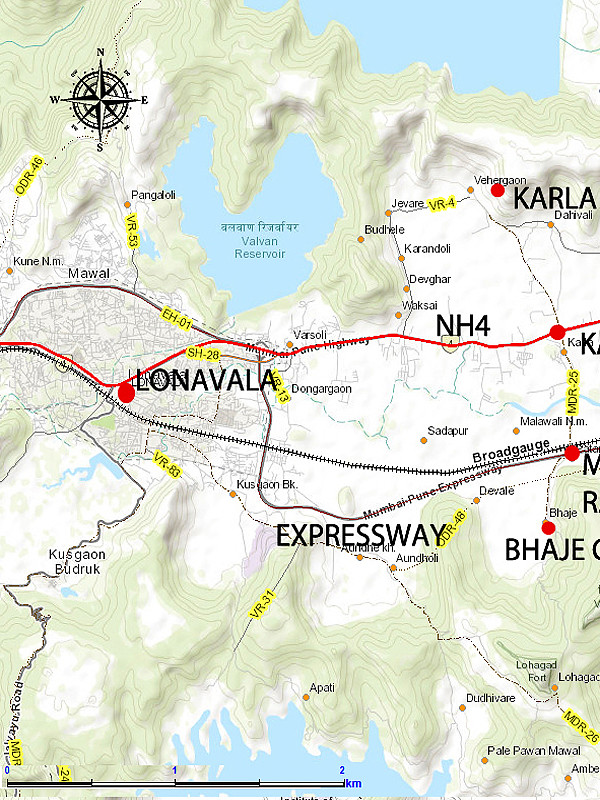 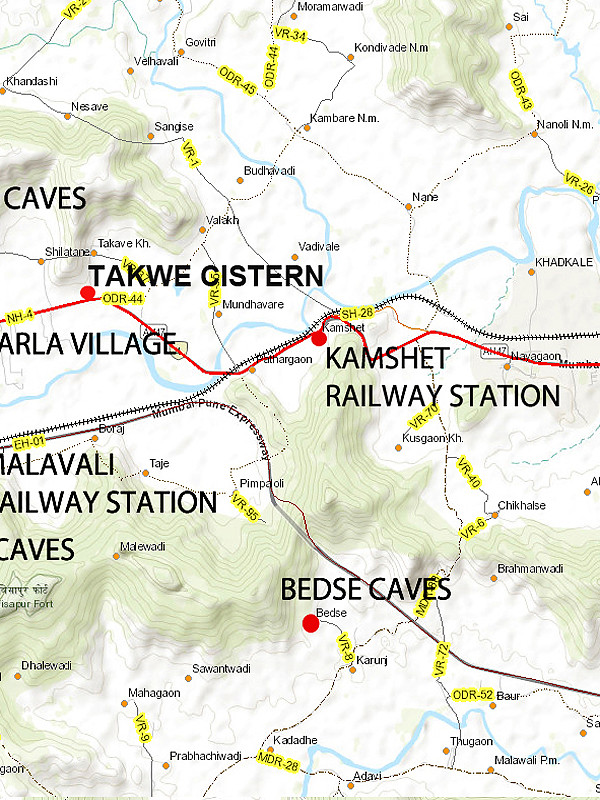 |
| |
| 3. Map- Takwe Khurd Cistern with Brahmi Inscriptions, Maval Tehsil, Pune district, Maharashtra, India |
| |
|
|
पुणे जिल्ह्यातील मावळ तालुक्यातील कार्ले, भाजे आणि बेडसे लेणी समुहांजवळ, डोंगराळ भागात काही लहान अलिप्त गुहा आणि लेणी आहेत. यातील एक कपार लेणे शिलाटणे गावाजवळ डोंगरात आहे. या अल्प परिचित लेण्याचा फारसा अभ्यास झाला नसावा. जेम्स फर्ग्युसन आणि जेम्स बर्जेस या इंग्रज अभ्यासकांनी मावळ तालुक्यातील मुख्य लेणी समुहाव्यतिरिक्त या शिलाटणे कपार लेण्याचा उल्लेख त्यांच्या "केव्ह टेंपल्स ऑफ़ इंडिया" या १८८० साली प्रकाशित केलेल्या पुस्तकात केला आहे. या लेण्याव्यतिरिक्त त्यांनी शिलाटणे गावाच्या पूर्वेला असलेल्या टाकवे गावातील दोन पाण्याच्या टाक्यांचा उल्लेख त्यांच्या पुस्तकात केला आहे.
मावळ तालुक्यात टाकवे नावाची दोन गाव आहेत. यातील एक गाव टाकवे खुर्द तर दुसरे गाव टाकवे बुद्रुक या नावाने ओळखले जाते.
शिलाटणे गावाजवळ डोंगराच्या दुसऱ्या बाजुला टाकवे खुर्द हे गाव वसलेले आहे. त्यामुळे जेम्स फर्ग्युसन आणि जेम्स बर्जेस यांनी नमुद केलेले टाकवे गाव टाकवे खुर्द आहे हे स्पष्ट आहे. इंग्रज अभ्यासकांनी टाकवे येथे दोन टाक्यांचा उल्लेख केलेला आहे. टाकवे येथील शिलालेख असलेले टाके, गावापासुन पाऊण किलोमीटर दुर आहे. टाके गावात नसुन वेशीजवळ आहे. दुसरे टाके पाहण्यात आले नाही.
जेम्स फर्ग्युसन आणि जेम्स बर्जेस यांनी नमुद केलेली दोन टाकी नक्की कुठे आहेत हा प्रश्न अनुत्तरित आहे.
एक शक्यता आहे की त्यांनी नमुद केलेली टाकी गावात आहेत. शिलालेख असलेले टाके त्यांनी नमुद केलेल्या टाक्यांपैकी नाही. या तर्कास दुजोरा देणाऱ्या चार बाबी आहेत.
१) जेम्स फर्ग्युसन आणि जेम्स बर्जेस यांनी उल्लेख केलेली टाकी गावात आहेत असे त्यांनी नमुद केले आहे. शिलालेख असलेले टाके गावापासुन बरेच दुर (पाउण कि.मी.) आहे.
२) जेम्स फर्ग्युसन आणि जेम्स बर्जेस यांनी दोन टाक्यांचा उल्लेख केलेला आहे. शिलालेख असलेले टाके एकच आहे.
३) शिलालेख असलेले टाके वैशिष्ट्यपुर्ण असुन सुद्धा, इंग्रज अभ्यासकांनी त्याचे नीट वर्णन केलेले नाही. पण शिलाटणे च्या टाक्यांचे मात्र त्यांनी नीट वर्णन केले आहे.
४) काही महिन्यांपुर्वी टाकवे गावात शेतात काम करताना दोन पाण्याची टाकी सापडल्याचे वर्तमानपत्रात आले आहे. (आम्ही अजुन हे पडताळुन पाहिलेले नाही.)
वरिल तर्क अयोग्य मानल्यास, शिलालेख असलेले टाके, जेम्स फर्ग्युसन आणि जेम्स बर्जेस यांनी नमुद केलेल्या टाक्यांपैकी एक असे समजले तर, दुसरे टाके नष्ट झाले असावे. टाक्याच्या मागच्या बाजुला असलेल्या विहिरीलगतच्या मोठया खाणीत दुसरे टाके नष्ट झाले असावे असे वाटते.
|
|
Around the famous Karle, Bhaje and Bedse Caves in Maval Tehsil of Pune district there are many smaller hermit caves in the hills. One of the interesting wonderful hermits is located in the hill near village called as Shilatane. This cave is not so well known and is not probably studied and documented. James Fergusson and James Burgess the noted explorers of Buddhist rock cut caves, around Pune have mentioned about this place in their book “Caves temples of India (1880)”. With reference to the study of the Shilatane cave, James Fergusson and James Burgess have made a passing mention about the two water cisterns at Takwe Khurd, east of Shilatane. There are two Takwe Khurd villages in Maval, viz. Takwe Khurd and Takwe Khurd Budruk. So based on the vicinity to Shilatane, we guessed that it is Takwe Khurd . The other point to be noted is that Fergusson and Burgess mentioned two water cisterns in Takwe Khurd village. I have serious doubt that the water cistern with inscriptions is different than the two water cisterns Fergusson has mentioned.
There are few reasons as to why I think so.
1) Fergusson has mentioned that the water cisterns are in the village, and not on the outskirt.
2) They have mentioned two water cisterns and not one.
3) While Fergusson described Shilatane cisterns in greater details, he did not do so about Takwe Khurd cistern. Takwe Khurd cistern has greater details, which could not have been overlooked by Fergusson. The fact that Fergusson has not described important features of Takwe Khurd cistern clearly indicates that the water cisterns he has mentioned in the village are different than the water cistern with Inscriptions on the outskirts of the village.
4) Incidentally there was news that two small water cisterns were recorded last year during the clearance work in the village.
If not so then the second cistern is lost probabaly in the stone mine, just behind the present water cistern.
|
|
|
| |
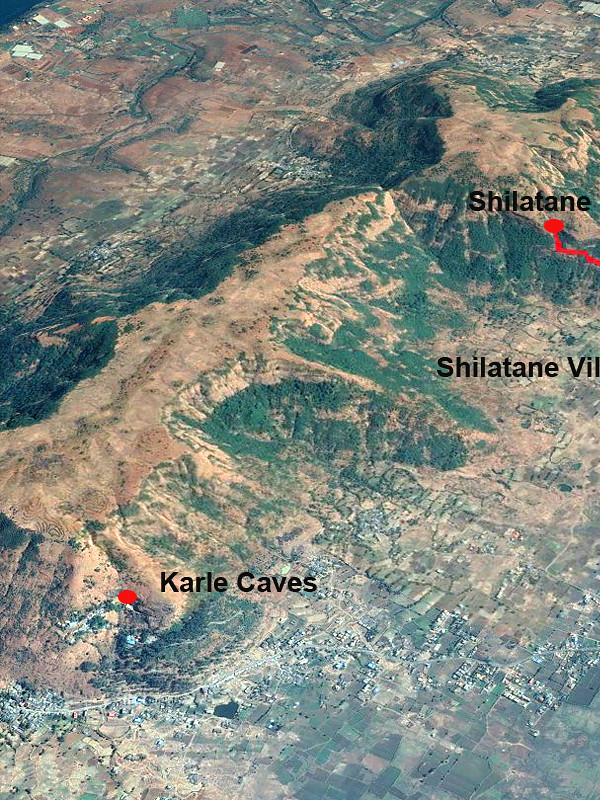 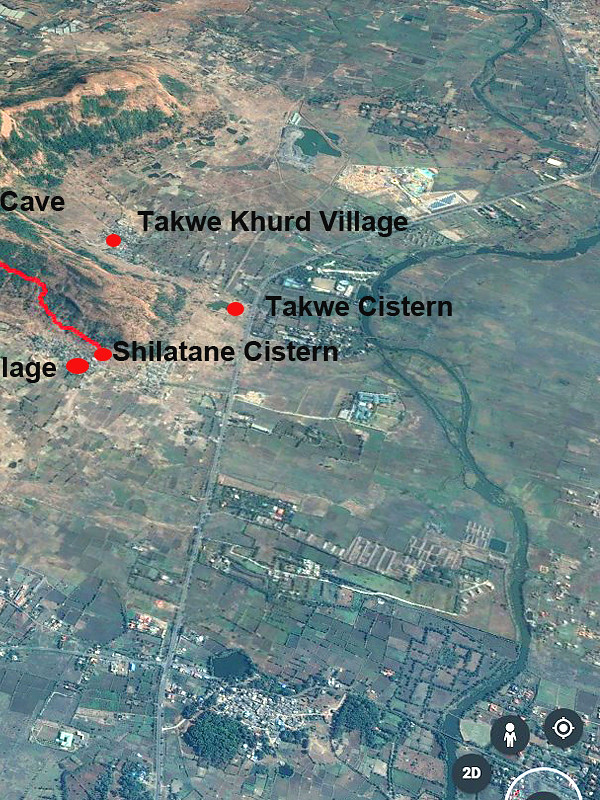 |
| |
| 4. Map-Takwe Khurd Cistern with Brahmi Inscriptions, Maval Tehsil, Pune district, Maharashtra, India |
| |
|
|
शिलाटणे हे पुणे जिल्ह्याच्या मावळ तालुक्यात असलेले एक गाव आहे. हे गाव सह्याद्रीच्या कार्ले डोंगररांगेच्या कुशीत वसलेले आहे. ही डोंगररांग लोणावळेच्या उत्तरेस पश्चिम घाटापासुन पूर्वेकडे वाळख गावापर्यंत, १३ कि मी पसरलेली आहे. कार्ले डोंगररांग पश्चिम-पूर्व पसरलेली आहे, याच रांगेत कार्ले लेणी आहेत. कार्ले डोंगररांगेच्या दक्षिणेस समांतर विसापुर डोंगररांग पसरलेली आहे. विसापुर डोंगररांग पश्चिम घाटातील कुरवंडे गावापासुन पूर्वेला घोरावाडी डोंगरापर्यंत ३५ किमी पसरलेली आहे. विसापुर डोंगररांगेत, भाजे लेणी, बेडसे लेणी, लोहगड किल्ला, विसापुर किल्ला आणि शेलारवाडी लेणी या महत्वाची वारसा स्थळ आहेत. शिळा म्हणजे मोठे दगड. शिलाटणे या गावाच्या नावाचा अर्थ, "असे गाव जे कातळावर वसलेले आहे" असा होतो. हे गाव कातळावर वसलेले आहे.
कार्ले आणि विसापुर डोंगररांगांच्या मध्ये असलेल्या पठारी प्रदेशातुन इंद्रायणी नदी वाहते. इंद्रायणी पश्चिमेकडुन पूर्वेकडे वाहते. प्राचीन व्यापारी मार्ग या भागातुन इंद्रायणी खोऱ्यातुन जातो. हा प्राचीन व्यापारी मार्ग कोकणातल्या कल्य़ाण, सोपारा या बंदरांपासुन दक्खन च्या पठारावरच्या पैठण, तेर या गावांना जोडत होता. आज याच भागातुन मध्य रेल्वे आणि मुंबई-पुणे राष्ट्रीय मार्ग जातात. शिलाटणे गाव कार्ले डोंगररांगेच्या पूर्व बाजुस, प्राचीन व्यापारी मार्गावर वसलेले आहे. हे गाव मुंबई-पुणे राष्ट्रीय मार्गापासुन अर्धा किलोमीटर आत आहे.
|
|
Takwe Khurd is a village in Maval Taluka in Pune district in the state of Maharashtra in India. The village is located at the base of the hill range on the Deccan plateau. This hill range, which is about 13 km in length, is spread from the western ghat ridge north of Lonavala up to the village Walakh towards east. It is spread in west-east orientation. Karle caves are located in the southern scarp of this hill range. Further south another west-east oriented hill range is spread over about 35 km, from Kurvande at western ghat main ridge up to the Ghoravadi towards east. This hill range has important archaeological sites such as Bhaje caves, Lohgad, Visapur and Shelarwadi caves. Between Karle hill range and Visapur hill range, the Indrayani river flows from west to east, and the plateau is called as Indrayani basin. The ancient trade route climbs up the western ghat ridge from the Konkan over to the Deccan plateau at Lonavala at the western end of this river basin. This ancient trade route was used to transport the goods from to the eastern economic centres on the Deccan plateau to Kalyan and Sopara ports on the western coast. Today the modern Mumbai-Pune road and rail line passes through the same Indrayani river basin, which was used for ancient trade in the past. Takwe Khurd village is located on the southern base of Karle hill range east of Karle caves, close to the modern Mumbai-Pune old national highway (NH4), close to the eastern end of the Karle hill range.
|
|
|
| |
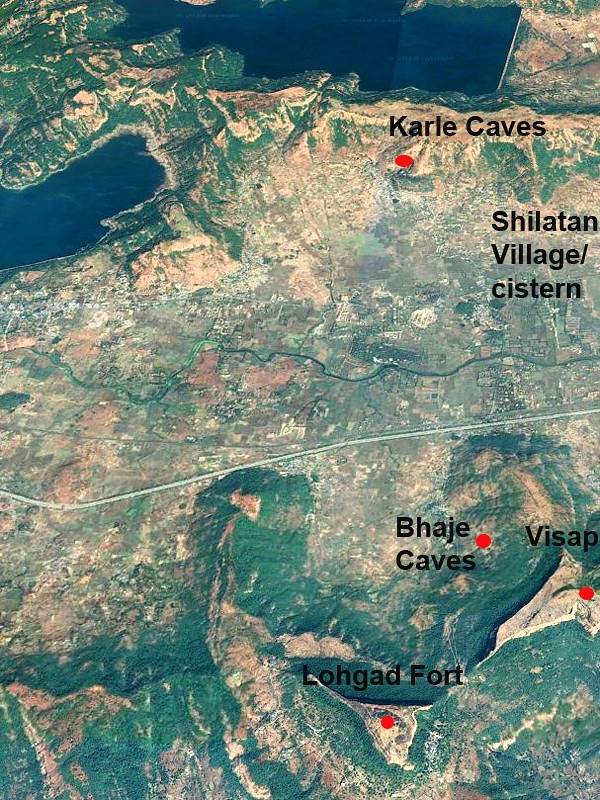 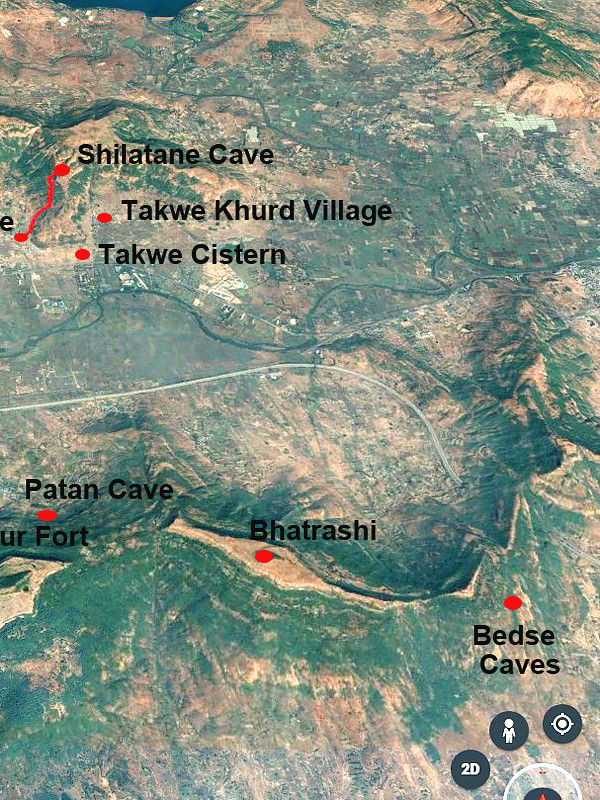 |
| |
| 5. Map-Takwe Khurd Cistern with Brahmi Inscriptions, Maval Tehsil, Pune district, Maharashtra, India |
| |
|
|
| |
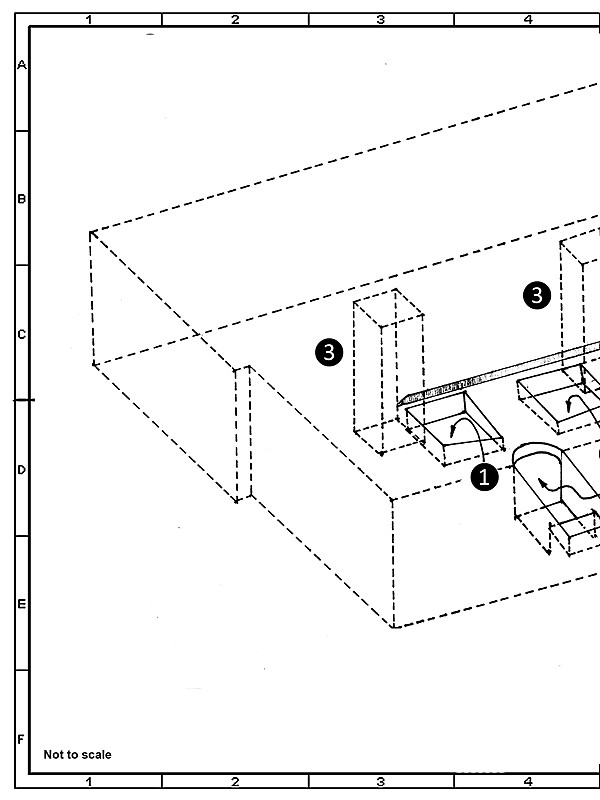 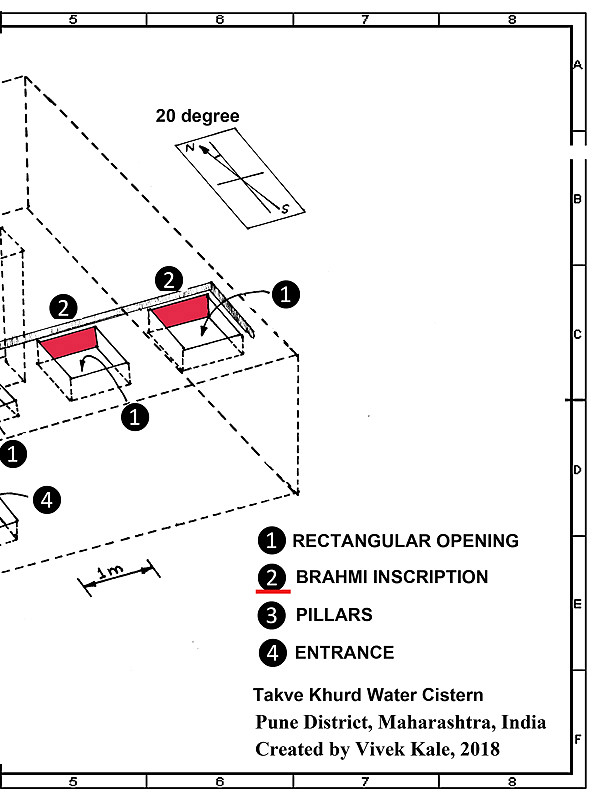 |
| |
| 6. Layout of Takwe Khurd Cistern with Brahmi Inscriptions, Maval Tehsil, Pune district, Maharashtra, India |
| |
|
|
| |
 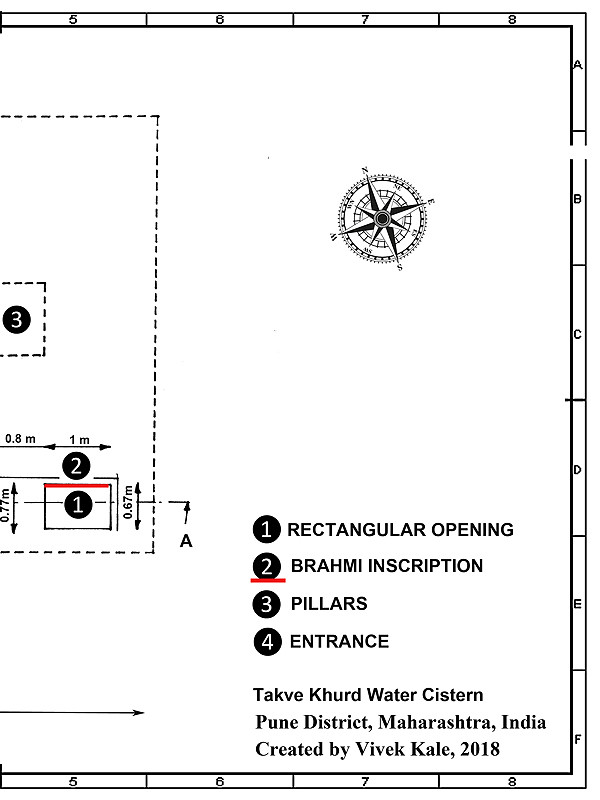 |
| |
| 7. Layout of Takwe Khurd Cistern with Brahmi Inscriptions, Maval Tehsil, Pune district, Maharashtra, India
|
| |
|
|
प्राचीन व्यापारी मार्ग कल्याण, सोपारा बंदरांपासुन, बोर घाटातुन लोणावळे मार्गे इंद्रायणी खोऱ्यातुन जात होता. या मार्गावर लोणावळे, मळवली या मावळ भागात पाण्याची टाकी आहेत. वळवण, वाकसई, शिलाटणे आणि टाकवे खुर्द येथील टाक्यांवर दोन ब्राह्मी शिलालेख आहेत. हे पाण्याचे टाके टाकवे खुर्द गावापासुन पाउण किलोमीटर अंतरावर, पुणे-मुंबई राष्ट्रीय महामार्गापासुन ९० मीटर अंतरावर कातळात खोदुन तयार केलेल आहे. या ठिकाणाची उंची ६१६ मीटर आहे. पाण्याचे टाके कार्ले डोंगररांगेजवळ आहे.
|
|
The various ancient water cisterns are located along the trade route in Maval tehesil. There are water cisterns near Valavan, Waksai, Shilatane and Takwe Khurd villages. The water cistern near Takwe Khurd village, which has two Brahmi inscriptions, is located at about 750 meter south of Takwe Khurd village and about 90 meter north of Mumbai–Pune old national highway (NH4). The GPS coordinates of the water cistern are latitude 18.76794° N, longitude 73.50066° E, elevation 616 meter above the mean sea level. The water cistern is located close to the hill extension off Karla hill range. Refer the map for further details of this region.
|
|
|
| |
  |
| |
| 8. Layout of Takwe Khurd Cistern with Brahmi Inscriptions, Maval Tehsil, Pune district, Maharashtra, India |
| |
|
|
पाण्याचे टाके : आधी उल्लेख केल्याप्रमाणे, टाकवे खुर्द चे पाण्याचे टाके, गावाबाहेर राष्ट्रीय महामार्गाजवळ आहे. सदर पाण्याचे टाके जमिनीखाली असुन, या टाक्याला पाच मुख आहेत. यातील चार मुख चौकोनी आकाराची आहेत. या मुखांलगत असलेल्या पायरीवजा खाच आहे. याचा उपयोग मुखांवर झाकण ठेवण्यासाठी होत असावा. पहिल्या आणि दुसऱ्या मुखाजवळ टाक्याच्या एका बाजुला, दोन पायऱ्या असलेले पाचवे मुख आहे. या पाण्याच्या टाक्याची क्षमता अंदाजे ११८००० लिटर आहे. या टाक्याच्या तिसऱ्या आणि चौथ्या मुखाच्या चौकटीतल्या उभ्या पतलावर दोन ब्राह्मी अस्पष्ट शिलालेख आहेत.
|
|
Water cistern: There is a water cistern south of Takwe Khurd village at location described earlier in this note. This water cistern is an underground rock cut structure, made in the basalt rock ground, close to the base of the hill. Two internal vertical pillars support the ceiling of the underground structure. There are four rectangular openings provided in the ceiling of this underground structure. The fifth opening is rock cut on the side, and has two steps to access the water cistern from the sides. There are two undocumented Brahmi inscriptions at this water cistern on the side flanks of the rectangular openings. The capacity of the water cistern is about 118000 litre water.
|
|
|
| |
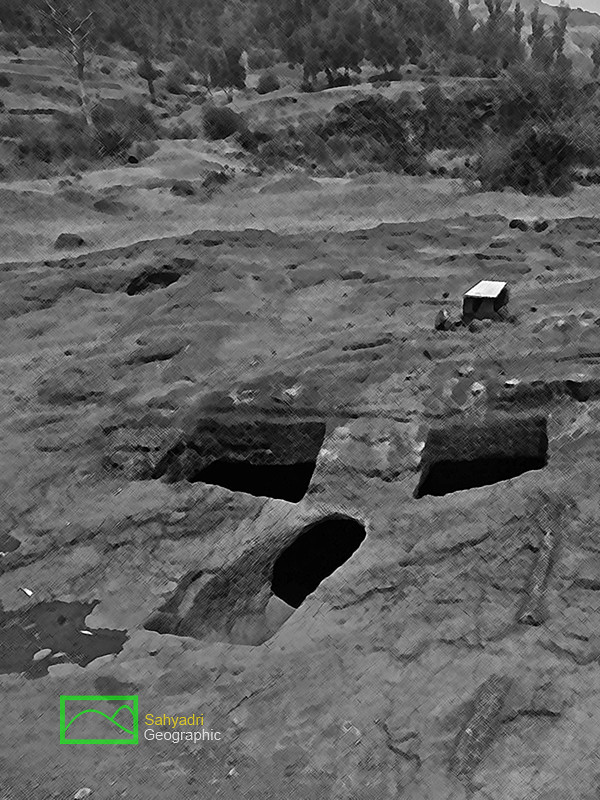 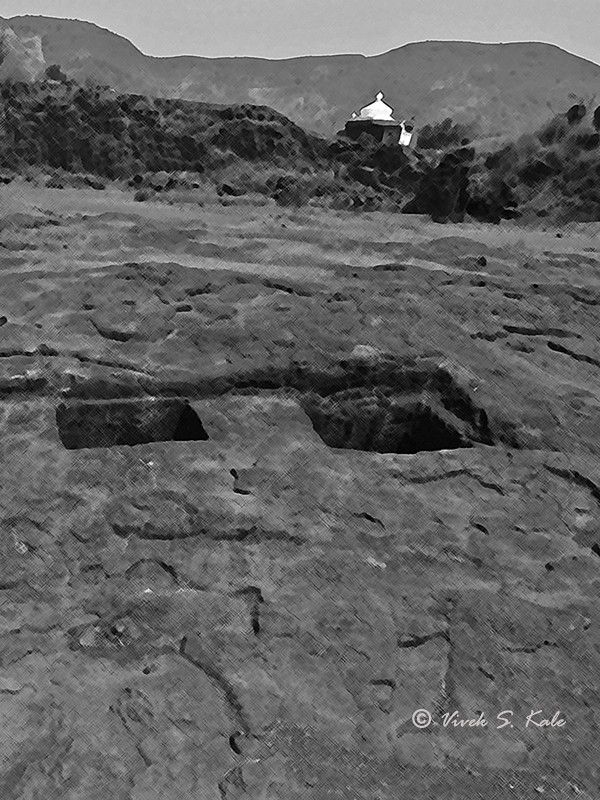 |
| |
| 9. Takwe Khurd Cistern with Brahmi Inscriptions, Maval Tehsil, Pune district, Maharashtra, India |
| |
|
|
ब्राह्मी शिलालेख : टाकवे येथील पाण्याच्या टाक्याला कातळात चार चौकोनी मुख (झरोके) आहेत. चार चौकोनी मुख (झरोके) एका रांगेत आहेत. पश्चिमेकडुन पुर्वेकडे मोजल्यास, तिसऱ्या आणि चौथ्या मुखावर (झरोक्यात) ब्राह्मी शिलालेख आहेत. दोन्ही शिलालेख अत्यंत अस्पष्ट आहेत. शिलालेख उघड़्यावर असल्याने पाण्याच्या प्रवाहामुळे धूप झाल्याने शिलालेख अस्पष्ट झाले असावेत. शिलालेखातील काही ब्राह्मी अक्षरे वाचता येतात. तिसऱ्या मुखावरचा शिलालेल्ख दोन ओळींचा तर चौथ्या मुखावरचा शिलालेख एक ओळीचा आहे. मावळात सहा इतर ठिकाणी ब्राह्मी शिलालेख आहेत. कार्ले लेणीसमुहात ३७ ब्राह्मी शिलालेख आहेत. बेडसे येथे ३, पाले येथे १, शेलारवाडी येथे २ आणि भाजे येथे १२ शिलालेख आहेत. विसापूर किल्ल्यावर ६ ब्राह्मी शिलालेख नोंदवले गेले आहेत. मावळात या सहा ठिकाणी मिळून ६१ ब्राह्मी शिलालेख आहेत. टाकवेखुर्द या सातव्या ठिकाणी टाक्यावर असलेले २ ब्राह्मी शिलालेख धरुन मावळातल्या एकूण ब्राह्मी शिलालेखांची संख्या ६३ आहे.
|
|
Brahmi Inscriptions: There are four rectangular openings in the ceiling of the underground tank, which open on the ground outside. These openings are linearly arranged in a row. The third opening counted from the west to east, has an inscription on its side flank facing south, as shown in sketch. This inscription is in Brahmi script. The inscription is eroded and is difficult to read. The erosion must have taken place as the surface is exposed to sun and flowing water in the monsoon. One letter in the first line such as “ma” can be easily be identified. This inscription is carved in two lines. The fourth opening counted from the west. to east, has an inscription on its side flank facing south, as shown in sketch. This inscription is in Brahmi script. The inscription is eroded and is difficult to read. The erosion of this inscription is less as compared to that on the third opening. The erosion must have taken place as the surface is exposed to sun and flowing water in the monsoon. This inscription is carved in a single line. The Maval region has several Buddhist caves where one can find the Brahmi inscriptions. Karle cave complex has 37 Brahmi inscriptions. Bhaje cave complex has 12 Brahmi inscriptions. Bedse cave complex has 3 Brahmi inscriptions. There are 2 Brahmi inscriptions at Shelarwadi caves and 1 Brahmi inscription at Pale caves. Visapur fort has 4 known Brahmi inscriptions. There are about 61 Brahmi inscriptions at these cave or fort complex all put together. These two inscriptions at Takwe Khurd water cistern are additional two more inscriptions apart from these 61 Brahmi inscriptions of Maval region, taking the total count to 63.
|
|
|
| |
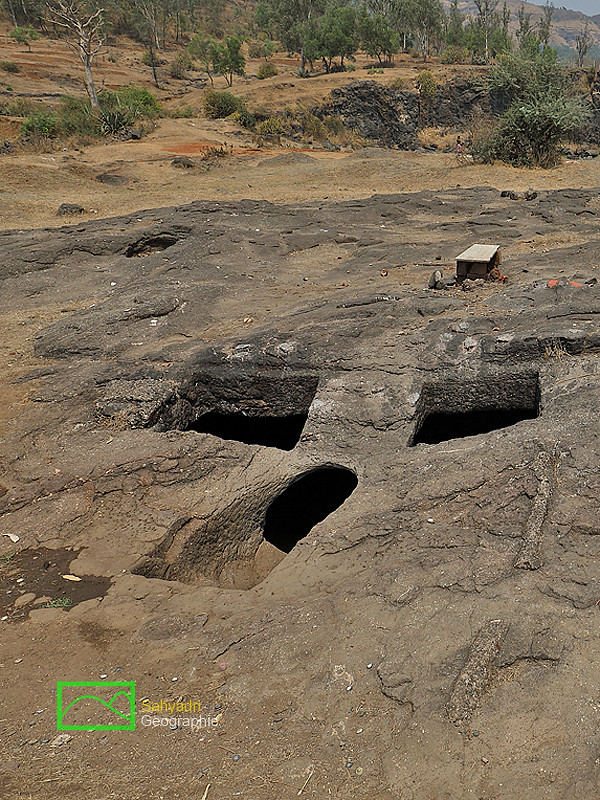 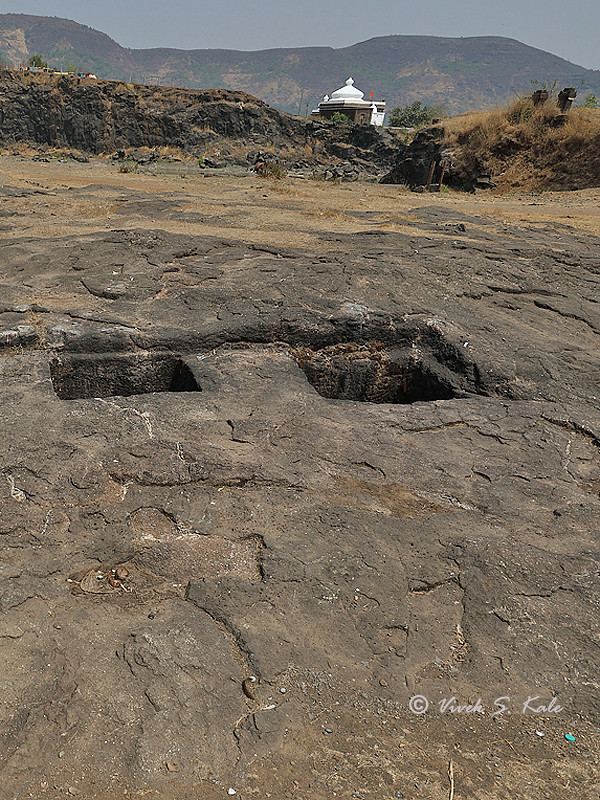 |
| |
| 10. Takwe Khurd Cistern with Brahmi Inscriptions, Maval Tehsil, Pune district, Maharashtra, India |
| |
|
|
कार्ले, भाजे आणि बेडसे येथील असलेल्या विविध शिलालेखांमध्ये काही शिलालेख पाण्याच्या टाक्यांवर/टाक्यांबद्दल आहेत. कार्ले, बेडसे, भाजे आणि पाले लेण्यांत प्रत्येकी एक शिलालेख पाण्याच्या टाक्यांवर/टाक्यांबद्दल आहे. विसापूर किल्यावर असे सहा शिलालेख पाण्याच्या टाक्यांवर आढळले आहेत. या सर्व शिलालेखांत विविध व्यक्तींनी टाक्यासाठी दान दिल्याचे नमुद केलेले आहे. कार्ले, बेडसे, भाजे,पाले आणि विसापूर चे शिलालेख डोंगरावरील लेणी समुहात अथवा किल्ल्यावर आहेत. टाकवे खुर्द च्या टाके मात्र कोणत्याही लेणी समुहात नसुन हे एक पठारावरचे व्यापारी मार्गावरचे पाण्याचे टाके आहे. त्यामुळे या शिलालेखांचा संबंध थेट व्यापारी मार्गाशी आहे. भाजे, बेडसे, आणि विसापूर चे शिलालेख हे उघड़्यावर दगडात कोरलेले असले तरी, टाक्यावरच्या भिंतीवर एक उथळ कोंदण करुन त्यात ते कोरलेले आहेत. टाकवे टाक्यांच्या मुखांच्या चौकटींवर मात्र कोंदण करण्यासाठी जागा नसल्याने, शिलालेखांचे पाण्यापासुन संरक्षण झालेले नाही.
|
|
There is one Brahmi inscription related to water cistern at each location, Karle, Bhaje, Bedse, and Pale. These inscriptions mention the donation by the donors for building the water cisterns. Apart from the Visapur inscriptions, Takwe Khurd Brahmi inscriptions are the only Brahmi inscriptions in Maval region outside the cave complex. Takwe Khurd Brahmi inscriptions are at the ground level on a water cistern along the ancient trade route, as compared to all other Brahmi inscriptions in the region which are seen at higher elevation on the hills. Takwe Khurd water cistern also is likely to be on the path from Karle to Bedse caves, through Vaghoba pass. The inscriptions on the trade route can be seen at other places such as on the Nane ghat trade route. The Visapur inscriptions are present on the likely path connecting Bhaje and Bedse Caves. The inscriptions at Bhaje, Visapur and Bedse water cisterns which are in open outdoor and are exposed to outdoor environment, have been made on the surface which is in recess as compared to the plan surface of the wall, thus protecting the inscriptions from the dripping, flowing water. Here at Takwe Khurd water cistern unfortunately the inscriptions are not made in recess, leading to the damage due to weather and flowing water in monsoon.
|
|
|
| |
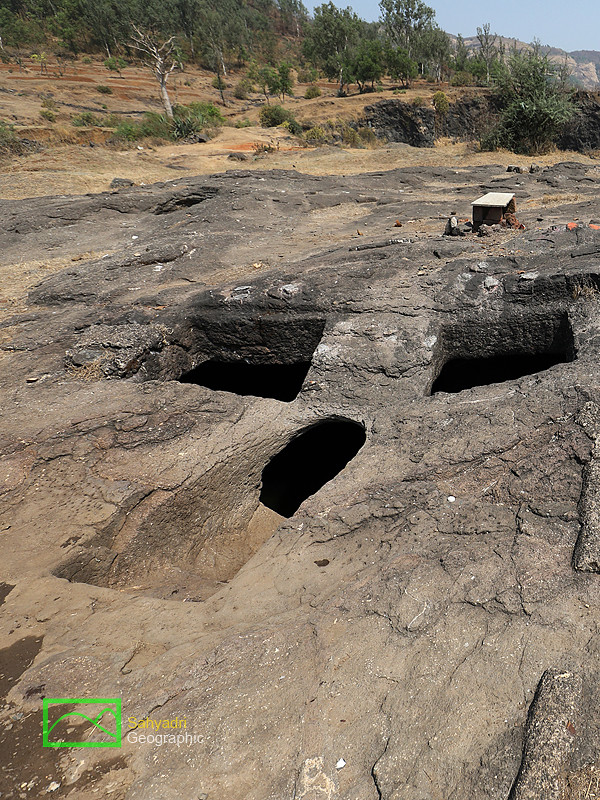  |
| |
| 11. Location of Inscriptions, Takwe Khurd Cistern with Brahmi Inscriptions, Maval Tehsil, Pune district, Maharashtra, India |
| |
|
|
पाण्याच्या टाक्याचे वर्णन : टाकवे च्या पाण्याची रचना साधी आहे. जमिनीवर कातळात चार मुख (झरोके) आहेत. जमिनीखाली कोरुन बनवलेल्या पोकळीत पाणी साठते. या पोकळीवर असलेल्या छताला आधार मिळावा म्हणुन दोन खांब आहेत. चार मुख (झरोके) एका रांगेत आहेत. पहिल्या आणि दुसऱ्या मुखाच्या बाजुला, एका माणसाला उतरता येईल असे, दोन पायऱ्या असलेले पाचवे मुख आहे. चार मुखांच्या भवताली एक पायरीवजा खाच आहे. झाकण ठेवण्यासाठी असलेली ही एक सोय असावी. टाक्यात गाळ आहे. याची एकूण खोली २.१ मीटर आहे. रुंदी ८.५ मीटर आहे. लांबी ६.७ मीटर आहे. या टाक्याची क्षमता अंदाजे ११८००० लीटर आहे. पावसाळ्यात मावळात भरपुर पाऊस पडतो. डोंगरौतारावरुन येणारे पाणी टाक्यात जमा होते. टाक्यात पाणी पडावे यासाठी विशेष रचना (पाट) नाही. पाणी मुख्यत्वे पाचव्या मुखातुन आत पडते. मार्च महिन्यात टाके पाण्याने अर्धे भरलेले होते. जुलै महिन्यात टाके पुर्ण भरते.
|
|
Architecture of the water cistern: There are four rectangular openings in the ceiling of the underground tank, which open on the ground above. These openings are linearly arranged in a row. There is a small peripheral rock cut step on the northern, eastern and western periphery of these openings. This is probably to locate the cover on the openings. The depth of the tank is about 2.1 meter. The width of the cistern is about 8.5 meters and breadth is about 6.7 meter. There are two rectangular pillars inside the tank to support the ceiling rock. There is a side opening apart from the four openings in the ceiling of the cistern. This side opening is just sufficient for one person to get down the steps and access the water from the side. It has two steps. This opening is located on the south side of the tank and is close to the first and second rectangular openings when counted from west to east. The approximate capacity of the water cistern is 118,000-litre water, if filled fully. As the Maval region has heavy rainfall in monsoon season, the tank will be filled full during the monsoon season. There are no direct visible channels on the land surface, which can direct the rainwater to the cistern. The tank was observed to be half filled in month of March 2018, indicating that the cistern has good water retention ability.
|
|
|
| |
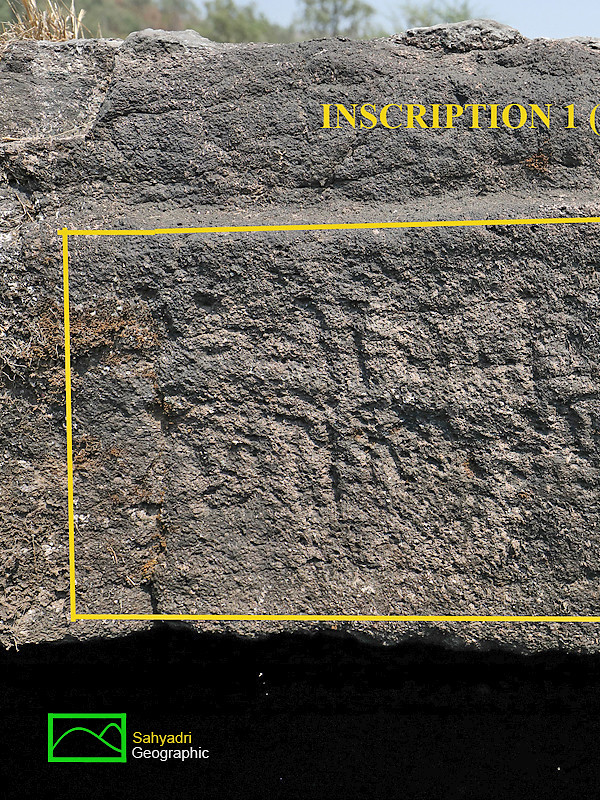  |
| |
| 12. Brahmi Inscription 1, Takwe Khurd Cistern with Brahmi Inscriptions, Maval Tehsil, Pune district, Maharashtra, India |
| |
|
|
पाण्याच्या टाक्याचा आजचा वापर :
टाकावे च्या पाण्याचा आज फारसा वापर होत नसला तरी जवळपासच्या काही घरातील माणस आज शुद्ध या पाण्याचा वापर करतात. टाक्याच्या मागे असलेल्या मोठ्या दगडाच्या खाणीत पाणी साठते. पाणी बारा महिने असते. हे खाणीतले पाणी ग्रामीण लोक कपडे धुणे, गुरे धुणे आणि गाडया धुण्यासाठी वापरतात. या खाणीत असलेल्या मुबलक पाण्यामुळे टाक्यातले पाणी फारसे महत्वाचे राहिलेलं नाही. जवळपास फारशी वस्ती नाही. वापार कमी झाल्याने टाक्याचे महत्व राहिलेलं नाही. यामुळे टाके नामशेष होण्याची भीती आहे. टाक्यावर एक लहान विटा रचून तयार केलेली देवळी आढळते. गावातलया बायका साती आसरा म्हणून या तांदळ्याची पूजा करतात. जवळ एक जुनी विहीर आहे. विहिरीजवळ काही जुनी व्रुदावंन आहेत. तरी काही कबरीचे दगड आढळतात. टाक्यापासून अंदाजे ७५-१०० मीटर अंतरावर एक दगडी देऊळ आहे. या देवळात भैरवांची पूजा होते. रस्त्यापलीकडे हनुमानाचे एक लहान देवस्थान आहे.
|
|
Current Practice of use of cistern: The water in the tank is clean and is used by the small local community residing around the cistern. However, a large stone quarry has been created on the northern side of the cistern. This quarry is also filled with harvested rainwater. There is also a small well, with constructed rock wall near the cistern on north side of the cistern, at the edge of the quarry. Locals use the water in the quarry and well for bath, washing the cloths, washing the vehicles and bathing the cattle. The dependence of the local community on the rock cut cistern is thus limited, due to presence of plenty of water in the quarry and the well. There is a modern deity above the cistern. The local women prey the Sati Asara deity, to overcome their problems. Another modern rock built temple in which Bhairav deity worshipped is located at about 100-meter distance on the northeast side of the water cistern.
|
|
|
| |
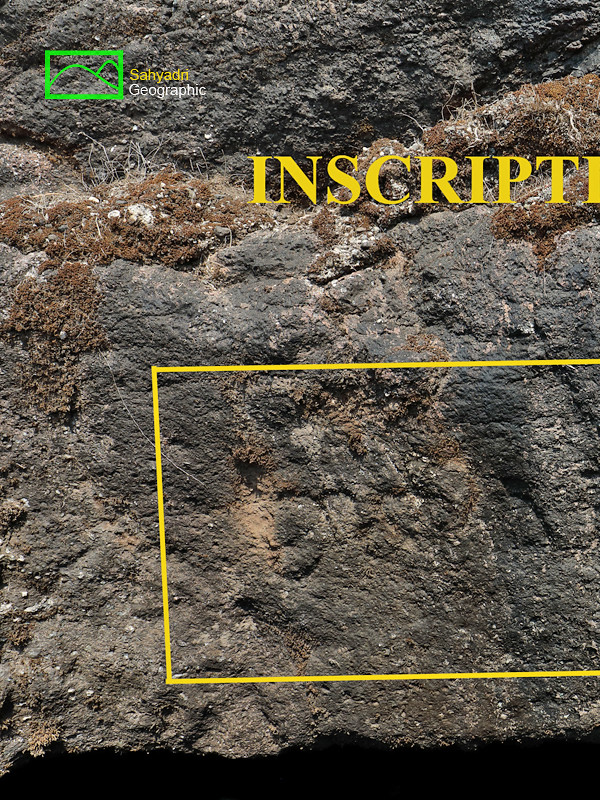 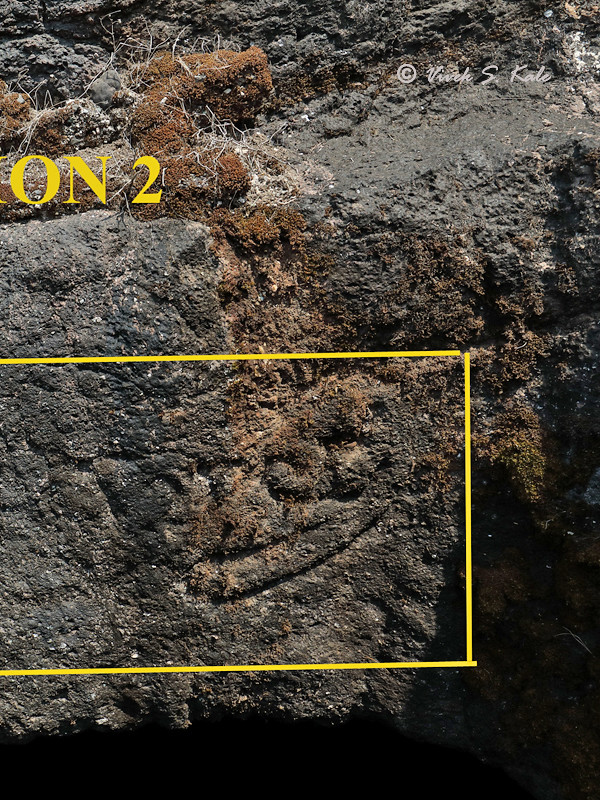 |
| |
| 13. Brahmi Inscription 2, Takwe Khurd Cistern with Brahmi Inscriptions, Maval Tehsil, Pune district, Maharashtra, India |
| |
|
|
जेम्स बर्जेस आणि जेम्स फर्ग्युसन या इंग्रज अभ्यासकांनी "केव्ह टेम्पल्स ऑफ इंडिया" या पुस्तकात टाकावे येथे दोन पाण्याची टाकी असल्याचे नमूद केलेले आहे. प्रत्यक्षात मात्र येथे एकाच पाण्याचे टाके आढळते. दुसरे टाके कदाचित खाणकामात नष्ट झाले असावे. पण असे असले तरी इंग्रज अभ्यासकांनी एवढ्या महत्वाच्या टाक्याचे वर्णन व्यवस्थित केलेले नाही हे आश्चर्य आहे. शिलालेख आणि इतर महत्वाच्या बाबी त्यानी नोंदवलेल्या नाहीत. यामुळे त्यांनी नोंदवलेल्या दोन टाक्या इतर कुठे आहेत का असा संभ्रम होतो.
. |
|
Earlier records: James Fergusson has mentioned about the two water cisterns at Takwe Khurd, east of Shilatane. However, it is not clear about the exact location of the cisterns he has described. As the above described pillared underground water cistern is located south of Takwe Khurd, and is only one in number, the cisterns he has described may be located in Takwe Khurd village as he has specifically mentioned so. The other possibility is that the two cisterns he mentioned is lost in the quary. The two water cisterns James Fergusson has mentioned are not traceable. There is no mention about the Brahmi inscriptions in reference 2.
|
|
|
| |
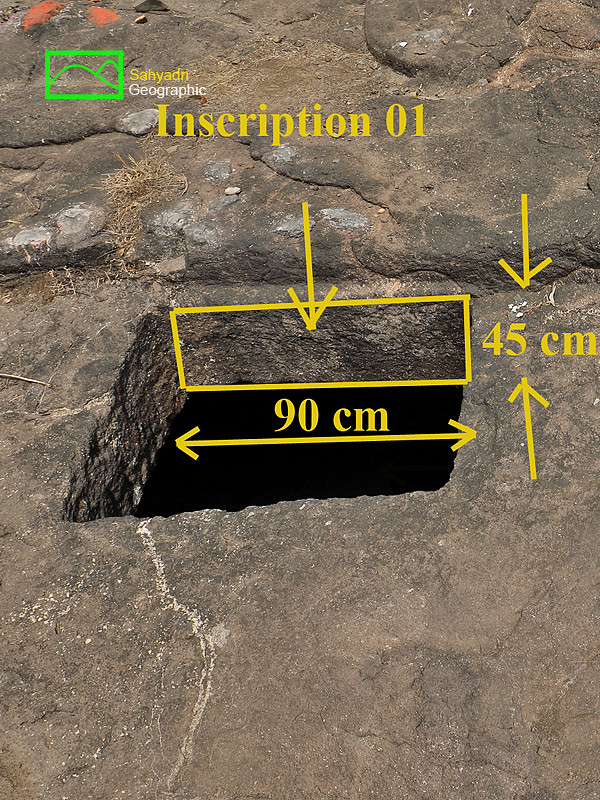 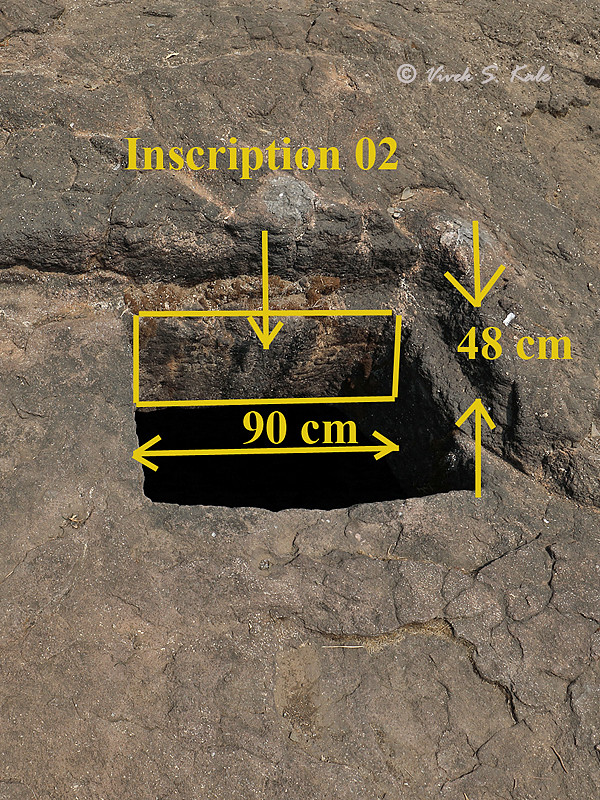 |
| |
| 14. Surfaces on which Inscriptions are engraved , Takwe Khurd Cistern with Brahmi Inscriptions, Maval Tehsil, Pune district, Maharashtra, India |
| |
|
|
टाकवे टाक्याचे भौगोलिक स्थान :
टाकवेचे पाण्याचे टाके प्राचीन व्यापारी मार्गाजवळ आहे. कल्याण, सोपारा या प्राचीन बंदरापासून दखनच्या पठारावर येणाऱ्या व्यापारी मार्गाजवळ मावळात काही ठिकाणी पाण्याची दुर्लक्षित टाकी आहेत. या टाक्यांच्या शृखलेत टाकवेचे पाण्याचे टाके सर्वात महत्वाचे आहे. पाण्याच्या टाक्यापासून शिलाटणे गाव एक किलोमीटर अंतरावर आहे. तर टाकवे गाव पाऊण किलोमीटर अंतरावर आहे. गाववस्तीपासून दूर असलेले हे टाके बनविण्याचे प्रयोजन व्यापारी मार्गावरच्या वाटसरुंची तहान भागवणे असे असावे असे वाटते. टाक्यावरच्या शिलालेखांचा संबंध व्यापारी वर्गाकडून मिळालेल्या दानाशी असावा असे वाटते.
टाकवे चे टाके खालील मार्गावर येत असावे.
१) कार्ले लेणी आणि दक्खन च्या पठारावरील पूर्वेकडील व्यापारी केंद्र यांना जोडणारा मार्ग
२) कार्ले लेणी आणि बेडसे लेणी यांना जोडणारा मार्ग
३) कल्याण /सोपारा आणि दक्खन च्या पठारावरील पूर्वेकडील व्यापारी केंद्र यांना जोडणारा मार्ग
४) शिलाटणे लेणी आणि व्यापारी मार्ग यांना जोडणारा मार्ग
५) भाजे लेणी आणि दक्खन च्या पठारावरील पूर्वेकडील व्यापारी केंद्र यांना जोडणारा मार्ग
|
|
Location of Takwe Khurd Cistern: The water cistern is located close to the ancient trade route between Kalyan/Sopara ports and the interior of Deccan plateau. The hill extension of the Karle hill range, at the base of which the subject cistern is located is used to cross the Karle hill range to go to the north side of this hill range towards NaneMaval. On this trail, up on the hill there is a small manmade cave north of Shilatane village in a cavern under the waterfall. This cave has a cylindrical chamber and a rock cut storage vessel. Today the nearest modern village from this water cistern is Takwe Khurd , which is located at about 750 meter north, and another village, Shilatane, is located at about 1 kilometer northeast of the water cistern. It is evident that the water cistern was used mainly to provide water to the travelling people on the ancient trade route, and not any village habitat. There are no poll marks on the rock surface around the water cistern. The traders or stakeholders of the trade are probably related to the inscriptions about the donations.
Takwe Khurd Cistern is likely to be on various tentative trails, namely
a) On the route between Karle Caves and Eastern Deccan plateau, towards Paithan, Junnar.
b) On the route between Karle Caves and Bedse Caves, through Vaghoba khind.
c) On the ancient trade route between eastern Deccan plateau and Kalyan, Sopara ports.
d) On the route between Ancient trade route and Shilatane Cave.
e) On the route between Bhaje Caves and Eastern Deccan plateau, towards Paithan, Junnar.
|
|
|
| |
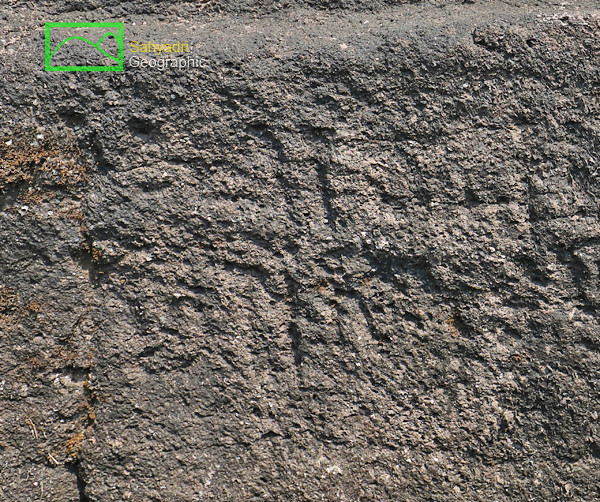 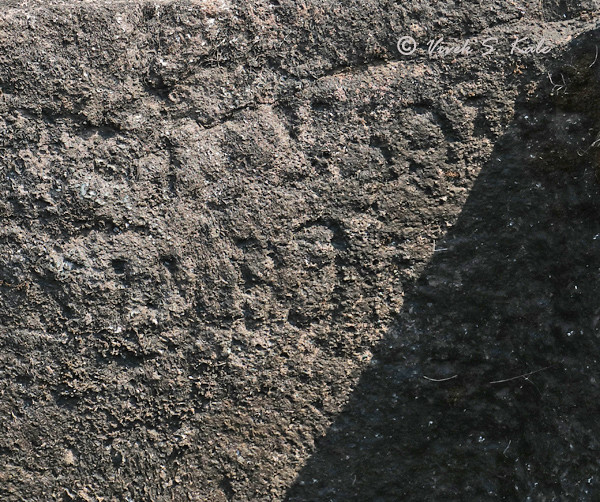 |
| |
| 15. Brahmi Inscription 1,Takwe Khurd Cistern with Brahmi Inscriptions, Maval Tehsil, Pune district, Maharashtra, India |
| |
|
|
शिलालेख १: टाकवे खुर्द च्या पाण्याच्या टाकयावर तिसऱ्या मुखावर (पश्चिमेकडून पूर्वेकडे मोजल्यास) दक्षिण मुखी पृष्ठभागावर पहिला शिलालेख आहे. हा शिलाललेख दोन ओळींचा आहे. पहिल्या ओळीत "क", "म" आणि "भ" सारखी ब्राह्मी अक्षरे ओळखता येतात. दुसऱ्या ओळीत काही अक्षरे ओळखता येतील. बाकी अक्षरे अस्पष्ट आहेत. शिलालेख ज्या पृष्ठभागावर कोरलेला आहे त्या पृष्ठभागावर शिलालेख कोरता यावा म्हणून बाकी मुखाच्या पृष्ठभागां पेक्षा तो जास्त सपाट केला आहे. विसापूर, भाजे येथील पाण्याच्या टाक्यावर शिलालेख आहेत. टाक्याच्या दर्शनी सपाट पृष्ठभागावर शिलालेख कोरलेला असतो. सपाट पृष्ठभागाच्या २०-२५ मिलीमीटर आतल्या पतलावर अजून एक सपाट पृष्ठभाग केलेला आढळतो. अशा थोड्या खोलीवर असलेल्या पृष्ठभागावर शिलालेख कोरलेलं आढळतात. शिलालेखाला आडोसा असतो. यामुळे शिलालेखाचे पाऊस पाण्यापासून संरक्षण होते. सपाट पृष्ठभागावर सुस्पष्ट अक्षरे कोरता येतात. टाकवे च्या टाक्यावर मात्र शिलालेख कोरण्यासाठी मोठा दर्शनी पृष्ठभाग उपलब्ध नाही. त्यामुळे शिलालेख लहान पृष्ठभागावर कोरलेला आहे. या पृष्ठभागाला आडोसा नाही. यामुळे शिलालेख दगडाची धूप झाल्यामुळे अस्पष्ट झाला आहे.
|
|
Inscription 1: This inscription is on the third opening of the cistern (counted from west to east), on the face which is facing south direction. It is a double line inscription with many letters. In the first line few letters such as”ka”, “ma”, “bha” can be identified. While in the second line, “Dhi” can be identified. Other letters are difficult to read due to damage of the surface. The surface is better finished for writing inscription as compared to other surfaces of the opening. Unlike many inscriptions, seen in other Maval caves and water cisterns, the inscription surface is not weather protected. The inscriptions at Visapur, Bhaje are weather protected, by creating an undercut recess for carving the inscription. As the heright of the face available here is very small, the recess surface could not be created here. The consecutive “ka” in first line prompt, as to wether the first word is Dhenukakata.
|
|
|
| |
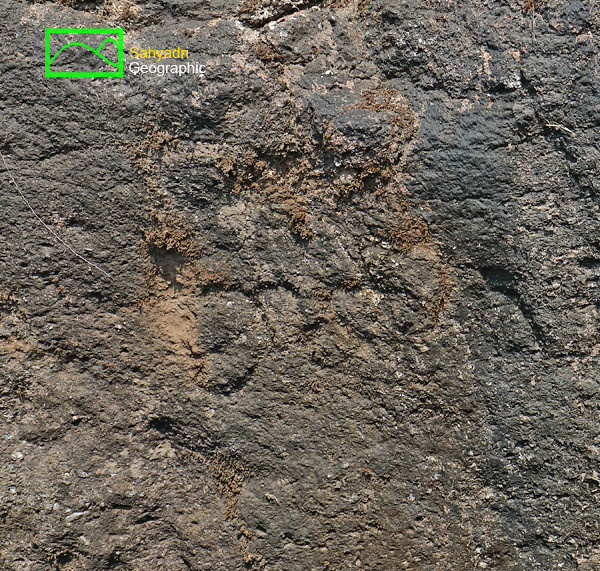 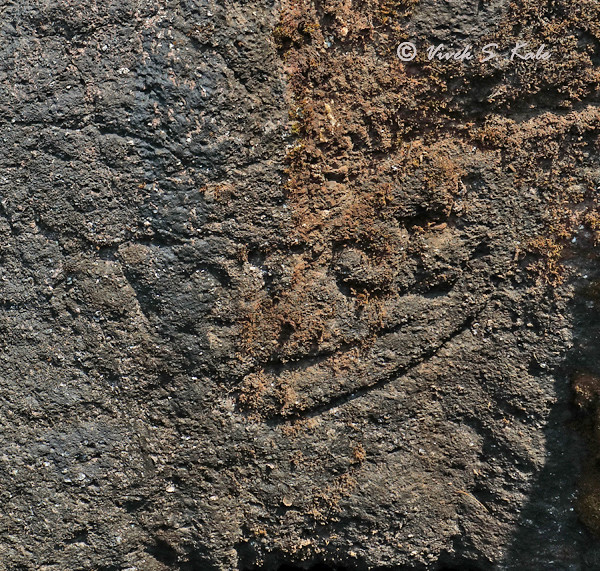 |
| |
| 16. Brahmi Inscription - 2, Takwe Khurd Cistern with Brahmi Inscriptions, Maval Tehsil, Pune district, Maharashtra, India |
| |
|
|
| |
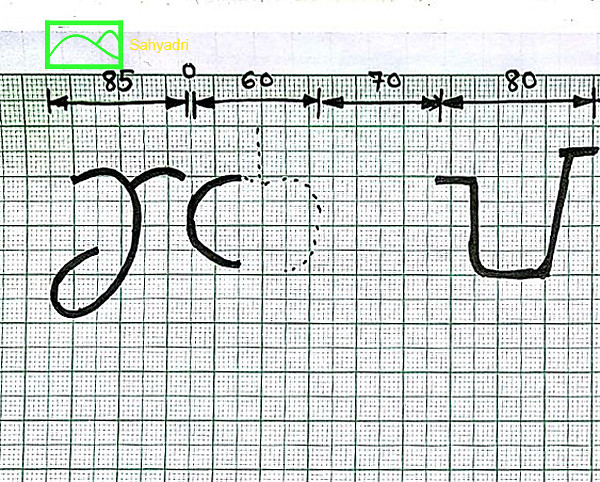 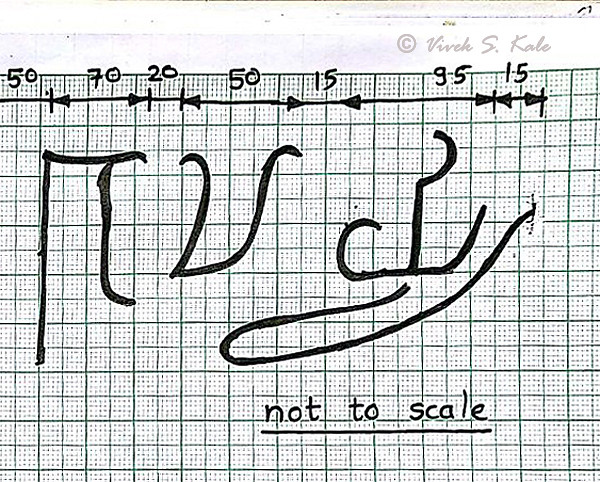 |
| |
| 17. Brahmi Inscription-2, Takwe Khurd Cistern with Brahmi Inscriptions, Maval Tehsil, Pune district, Maharashtra, India |
| |
|
|
शिलालेख २: टाकवे खुर्द च्या पाण्याच्या टाकयावर चौथ्या मुखावर (पश्चिमेकडून पूर्वेकडे मोजल्यास) दक्षिण मुखी पृष्ठभागावर दुसरा शिलालेख आहे. हा शिलालेख एक ओळींचा आहे. शिलालेखात " ख ", " पे " आणि " यी " सारखी ब्राह्मी अक्षरे ओळखता येतात. बाकी अक्षरे अस्पष्ट आहेत. यात अंदाजे ७ अक्षरे आहेत. या शिलालेखात शेवटी अखराखाली दोन समांतर रेघा मारलेल्या आढळतात शिलालेख ज्या पृष्ठभागावर कोरलेला आहे त्या पृष्ठभागावर शिलालेख कोरता यावा म्हणून बाकी मुखाच्या पृष्ठभागां पेक्षा तो जास्त सपाट केला आहे. विसापूर, भाजे येथील पाण्याच्या टाक्यावर शिलालेख आहेत. टाक्याच्या दर्शनी सपाट पृष्ठभागावर शिलालेख कोरलेला असतो. सपाट पृष्ठभागाच्या २०-२५ मिलीमीटर आतल्या पतलावर अजून एक सपाट पृष्ठभाग केलेला आढळतो. अशा थोड्या खोलीवर असलेल्या पृष्ठभागावर शिलालेख कोरलेलं आढळतात. शिलालेखाला आडोसा असतो. यामुळे शिलालेखाचे पाऊस पाण्यापासून संरक्षण होते. सपाट पृष्ठभागावर सुस्पष्ट अक्षरे कोरता येतात. टाकवे च्या टाक्यावर मात्र शिलालेख कोरण्यासाठी मोठा दर्शनी पृष्ठभाग उपलब्ध नाही. त्यामुळे शिलालेख लहान पृष्ठभागावर कोरलेला आहे. या पृष्ठभागाला आडोसा नाही. यामुळे शिलालेख दगडाची धूप झाल्यामुळे अस्पष्ट झाला आहे. हा दुसरा शिलालेख पहिल्या शिलालेखापेक्षा स्पष्ट आहे.
|
|
Inscription 2: It is a single line inscription with probably 7 letters based on the spacing. Out of these 7 letters, 3 Brahmi letters can be easily be identified. The first letter is “Khā”. The last letter is “Yi”, and a letter in fourth space is “Pe”. Other letters are difficult to read due to damage of the surface. Below the last letter “Yi”, one can see curved double lines which are probabaly the “Ukar” of earlier letter. The font size used in this inscription is larger than that seen in Inscription-1. The letter “yi” resembles more to the font of letters at Visapur, than that at Bhaje, Bedse and Karle caves.
|
|
|
| |
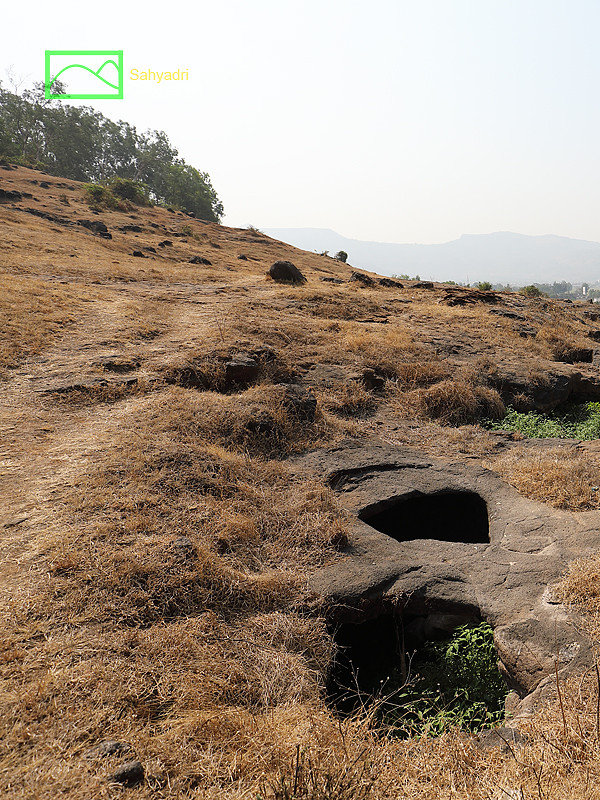 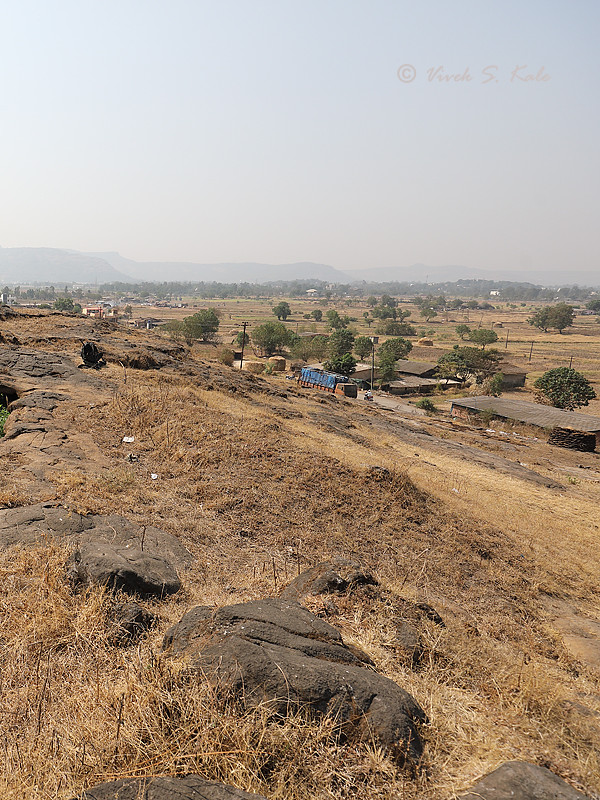 |
| |
| 18. Water cisterns at Shilatane Village, Maval Tehsil, Pune district, Maharashtra, India |
| |
|
|
शिलाटणे गावाच्या दक्षिण पुर्व दिशेला, डोंगर उतारावर दोन पाण्याची टाकी आहेत. या दोन टाक्यांपैकी एका टाक्याला २ झरोके आहेत, तर दुसऱ्या लगतच्या टाक्याला ४ झरोके आहेत. या टाक्यांचा उल्लेख जेम्स फर्ग्युसन आणि जेम्स बर्गेस यांच्या "केव्ह टेंपल्स ऑफ इंडिया" या १८८० साली प्रकाशित पुस्तकात आहे. या दोन्ही टाक्यात आज बराच गाळ आणि कचरा आहे. या टाक्यांचा शिलाटणे गावाजवळच्या लेण्यांशी संबंध असावा.
|
|
On south east end of Shilatane village little above the village level, on the hill slope, there are two underground water cisterns. One of the water cisterns has two irregular openings at top. The other water cistern has four irregular opendings at the top. These water cisterns are probabaly from the same era as that of the Shilatane cave. James Fergusson and James Burgess have described these water cisterns in Cave temples of India publication in 1880. Today the water cisterns are not in use and are half filled with rubble, and needs urgent attention
|
|
|
| |
 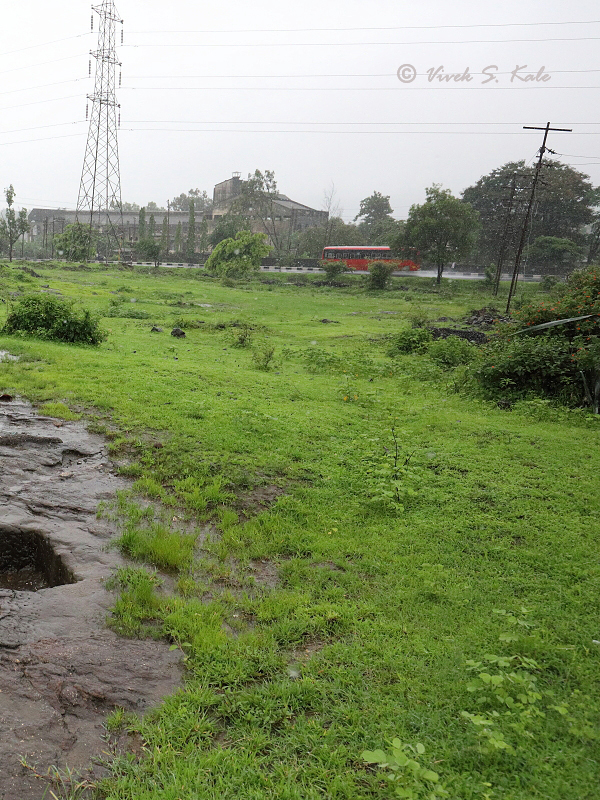 |
| |
| 19. Takwe Khurd Cistern with Brahmi Inscriptions, Maval Tehsil, Pune district, Maharashtra, India |
| |
|
|
टाकवे खुर्द येथील पाण्याच्या टाक्याचे महत्व :
टाकवे चे हे पाण्याचे टाके आणि येथील दोन ब्राह्मी शिलालेख, प्राचिन व्यापारी मार्गाचे अत्यंत महत्वाचे स्मारक आहे. इतिहास संशोधकांनी अशा स्मारकांचा अभ्यास करुन त्याचे महत्व सर्व जनतेला करुन देणे महत्वाचे आहे. शासन दरबारी या स्मारकाची नोंद होणे अत्यंत महत्वाचे आहे.
१) टाकवे खुर्द येथील एक पाण्याचे प्राचीन टाके सुस्थितीत आहे.
२) टाकवे खुर्द येथील प्राचीन टाके, प्राचीन व्यापारी मार्गावर (कल्याण/सोपारा या बंदरांपासून दक्खन पठारावर असलेल्या पूर्वेकडील व्यापारी गावाना जोडणाऱ्या ) आहे. व्यापारी मार्गावर असलेली एकमेव सुस्थितीत असलेली वास्तू आहे.
३) टाकवे खुर्द टाके या भागातील एक मोठे पाण्याचे टाके आहे.
४) टाकवे खुर्द येथील प्राचीन टाक्यावर दोन अस्पष्ट ब्राह्मी लिपीत लिहिलेले शिलालेख आहेत.
५) ब्राह्मी लिपीतले लेख अस्पष्ट असले तरी हे लेख आणि टाके इसवीसनानंतर पहिल्या ते चौथ्या शतकातले असावे. (१६००+ वर्षे जुने)
६) शिलालेखांचा संबंध व्यापारी वर्गाने किंवा तत्कालीन राजाने दिलेल्या देणगी शी असावा.
७) टाकवे खुर्द येथील पाण्याचे प्राचीन टाके राष्ट्रीय महामार्गापासून अवघे ९० मीटर अंतरावर असून ते रस्ता किंवा रस्त्याजवळच्या एखाद्या मानवी प्रगती? कामात नष्ट होऊ शकते. यामुळे या टाक्याची योग्य संवर्धनयुक्त नोंद शासकीय यंत्रणेकडे होणे महत्वाचे आहे.
|
|
The Takwe khurd water cistern needs to be protected by Govt. authorities as the important heritage of the ancient trade route. The indologists should come forward to study this water cistern so that the significance is understood by the larger community.The Significance of Takwe Khurd Water Cistern :
1) The Takwe Cistern is located on the ancient trade route between Sopara, Kalyan to Deccan plateau via Bor ghat and Lonavale.
2) The Takwe Cistern is one of the largest water cisterns in Maval region.
3) There are 2 brahmi inscriptions at Takwe cistern.most likely in Pali language.
4) Inscriptions indicate that it is dated between 1st and 4th century AD. (1600+ years old).
5) The Takwe Cistern is in good shape unlike other water cisterns on the trade route in Maval, and still in use.
6) The inscriptions are most likely related to the traders or the kings (Satvahan/Kshatrapa) of that era, and if deciphered may throw more light on the past.
7) The water cistern is located just 90 meters from Highway and thus may get destroyed due to road, peripheral development which has become rampant in recent years in this region. Hence immediate attention needs to be given to the water cistern by the Govt. authorities.
|
|
|
| |
 |
| |
|
|
References :
1. Cave temples of India, London, 1880, Fergusson James and Burgess James.
2. Gazetters of Bombay Presidency, Poona District, Volume XVIII, 1885.
3. Buddhist architecture of western India, 1981, S. Nagraju.
4. Burgess James and Inderaji Pandit Bhagavanlal, Inscriptions from the cave temples of western India, ASWI X, London, 1881.
|
| |
|
|
| |
|











































